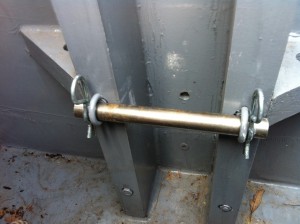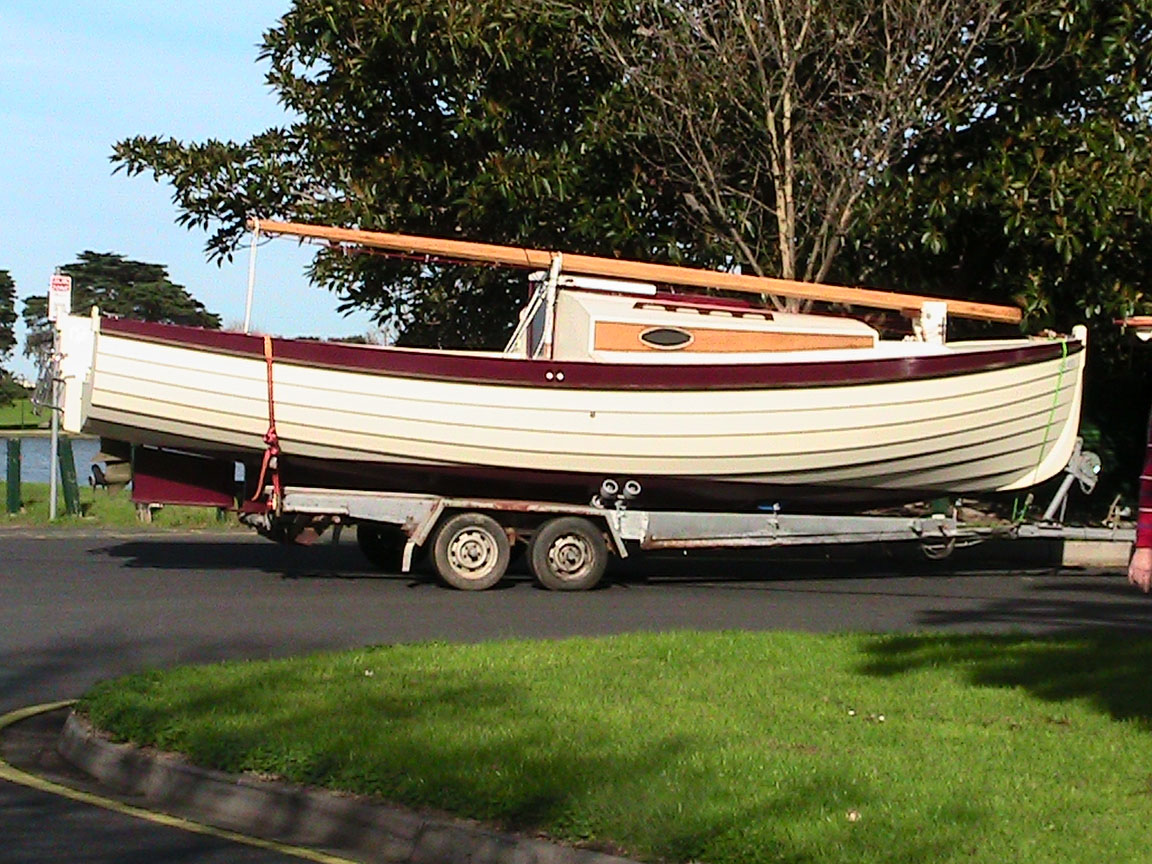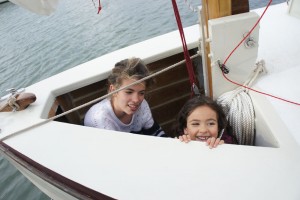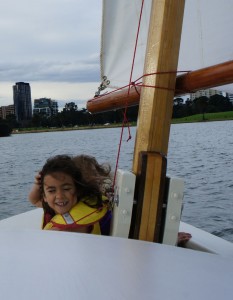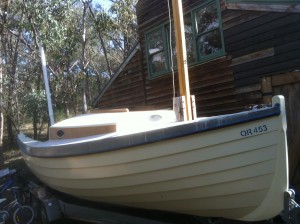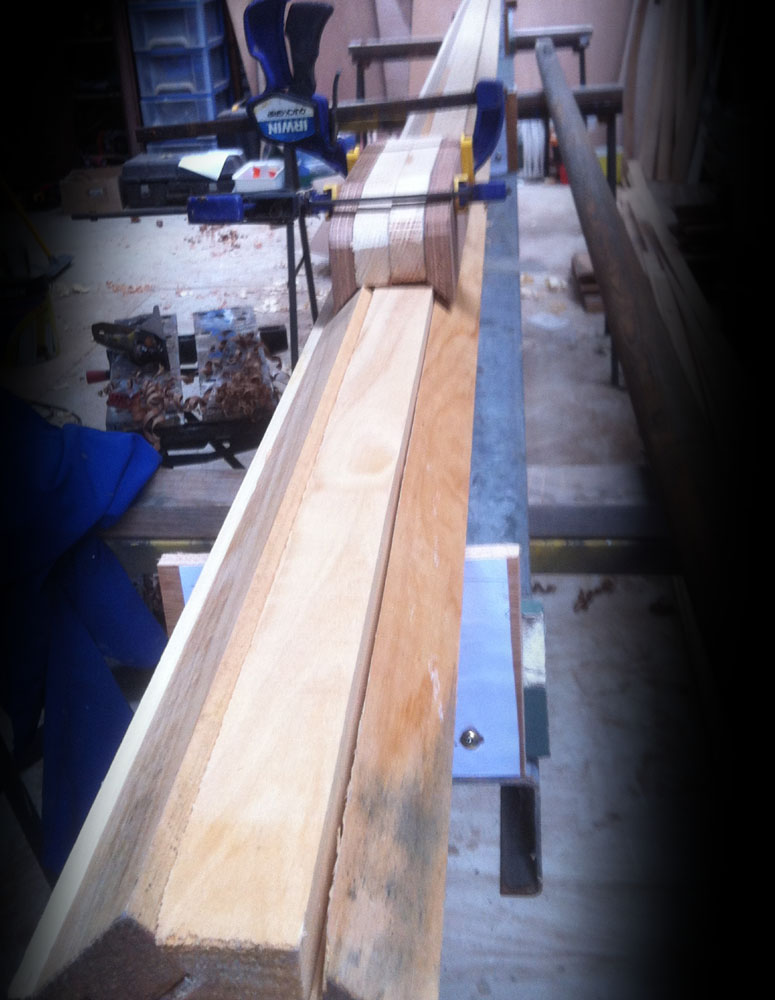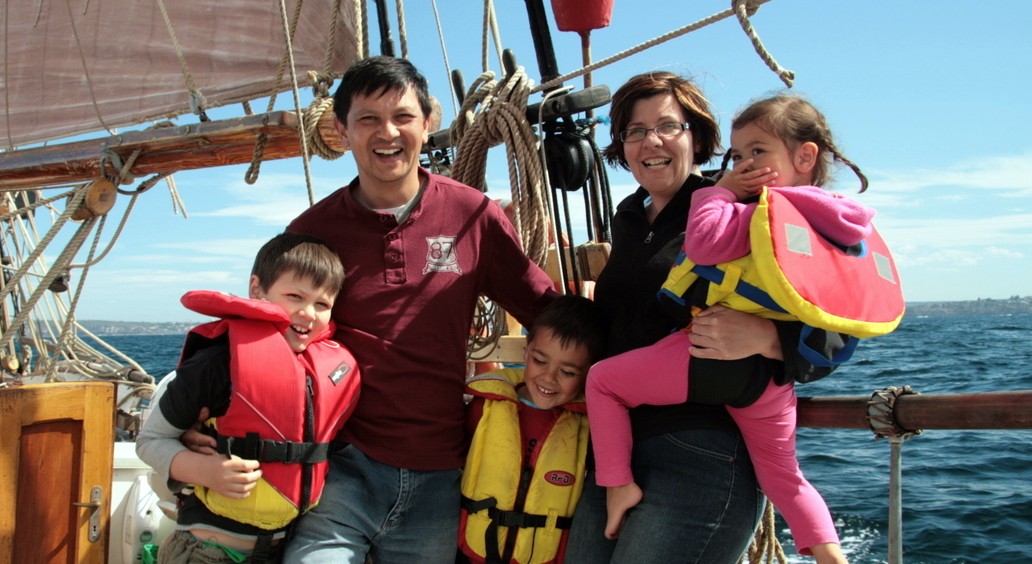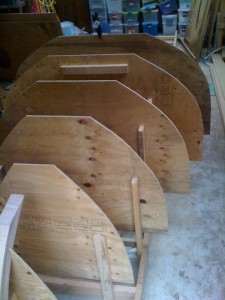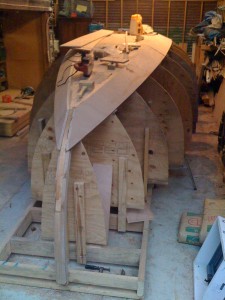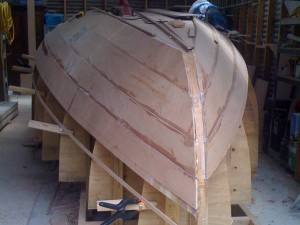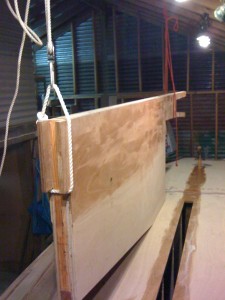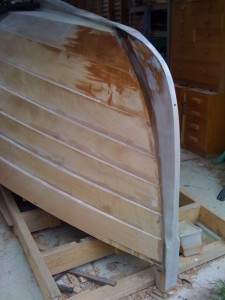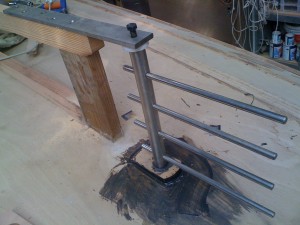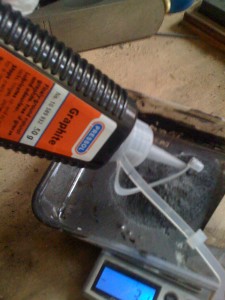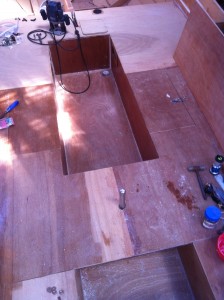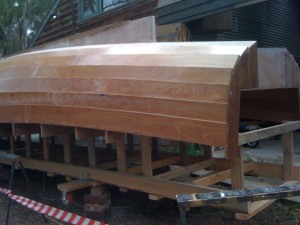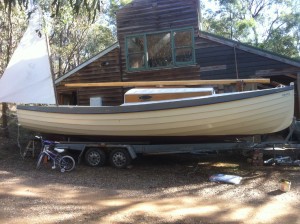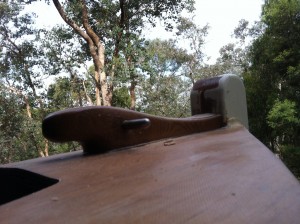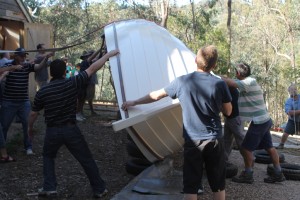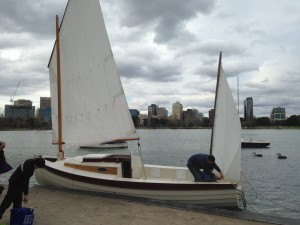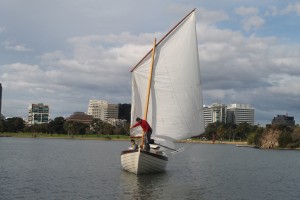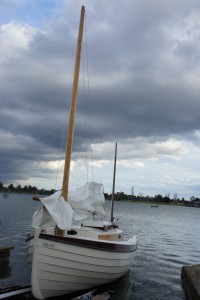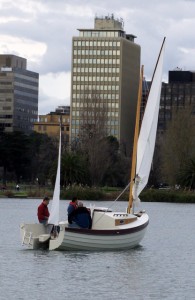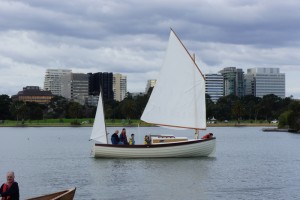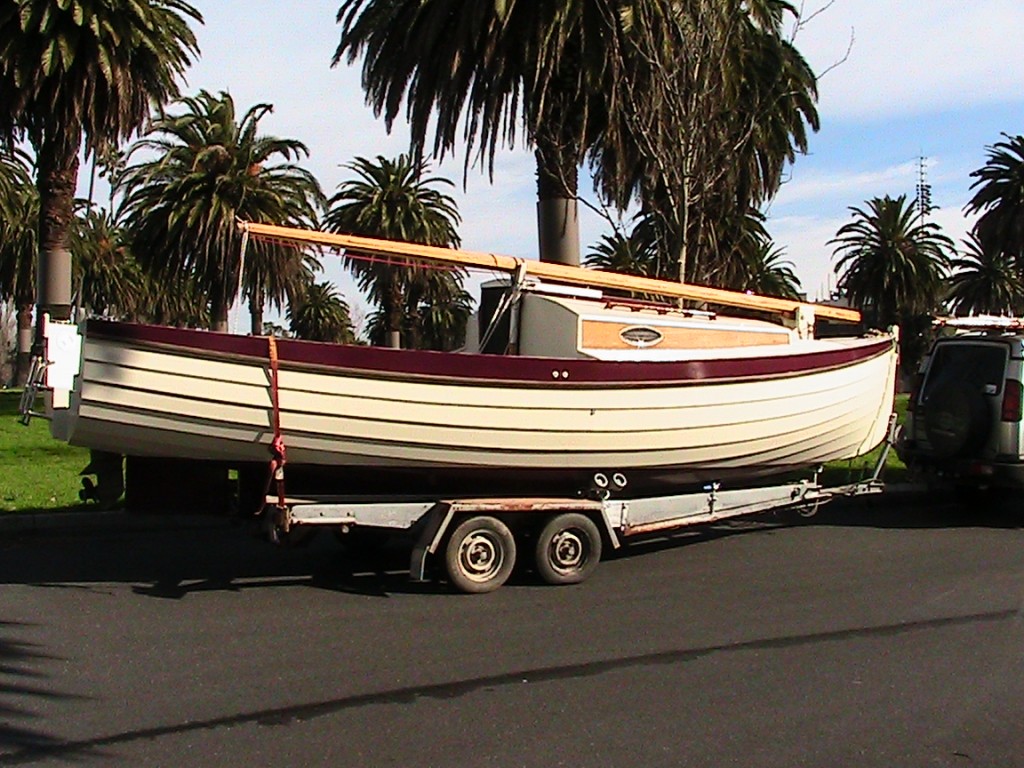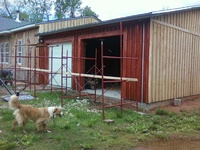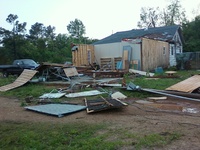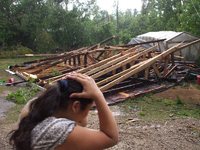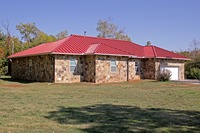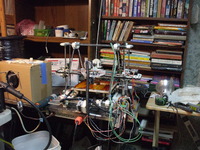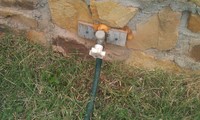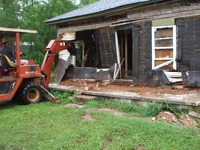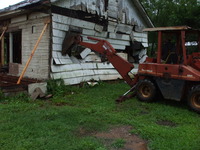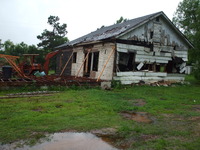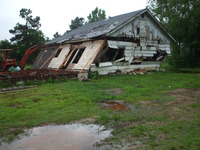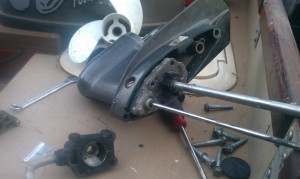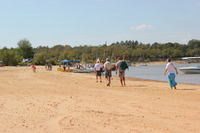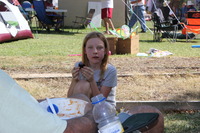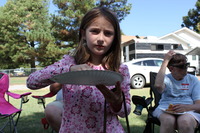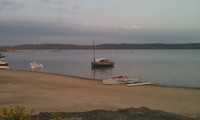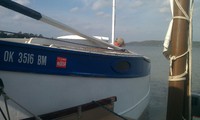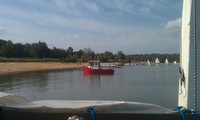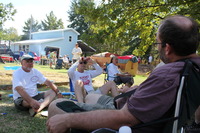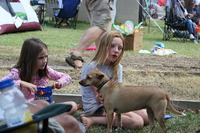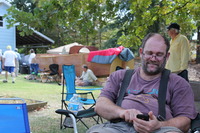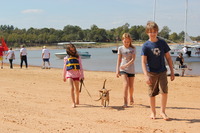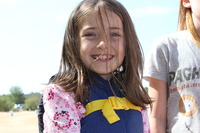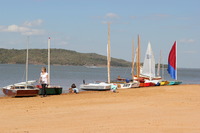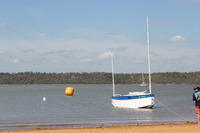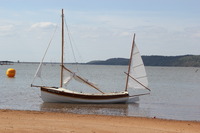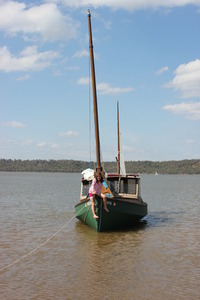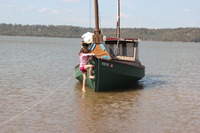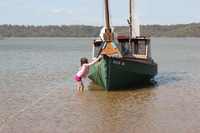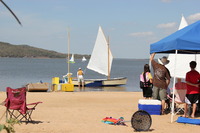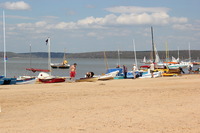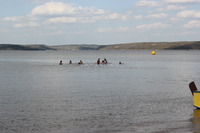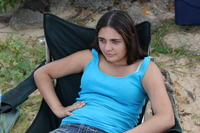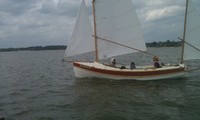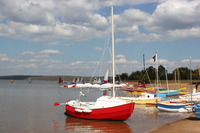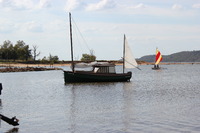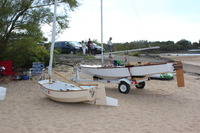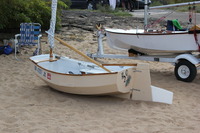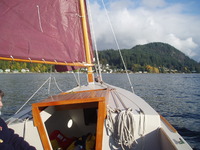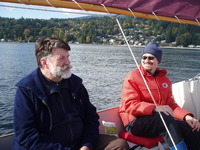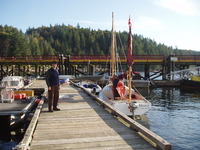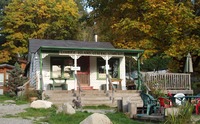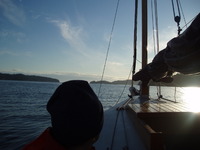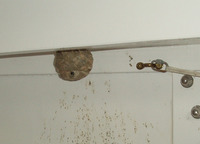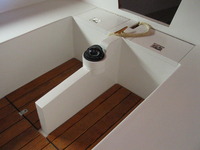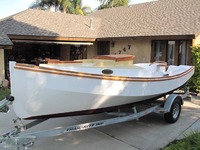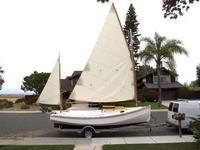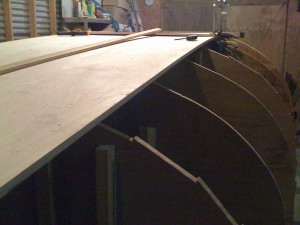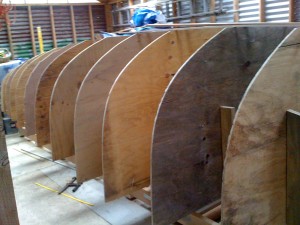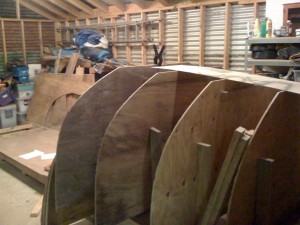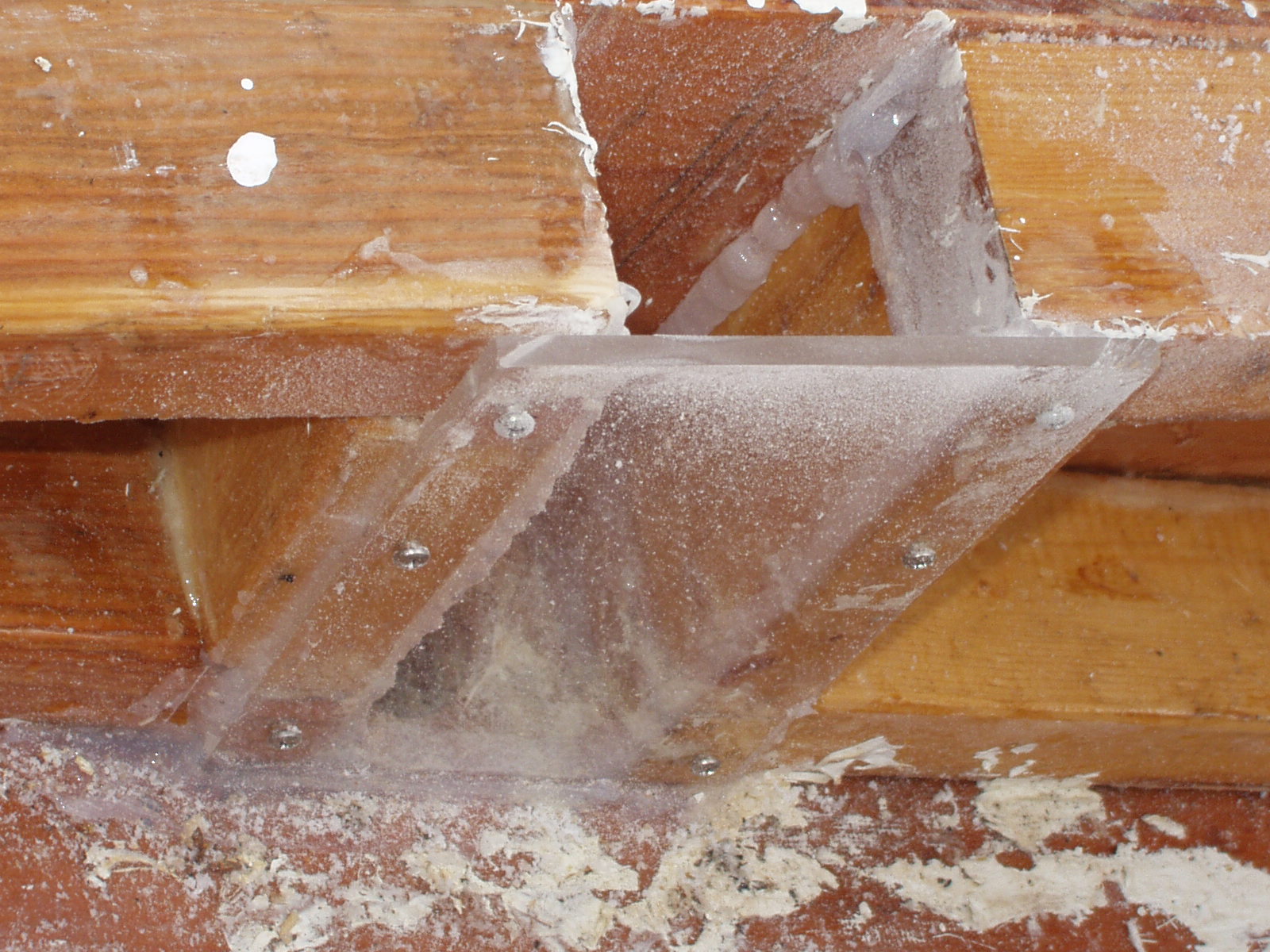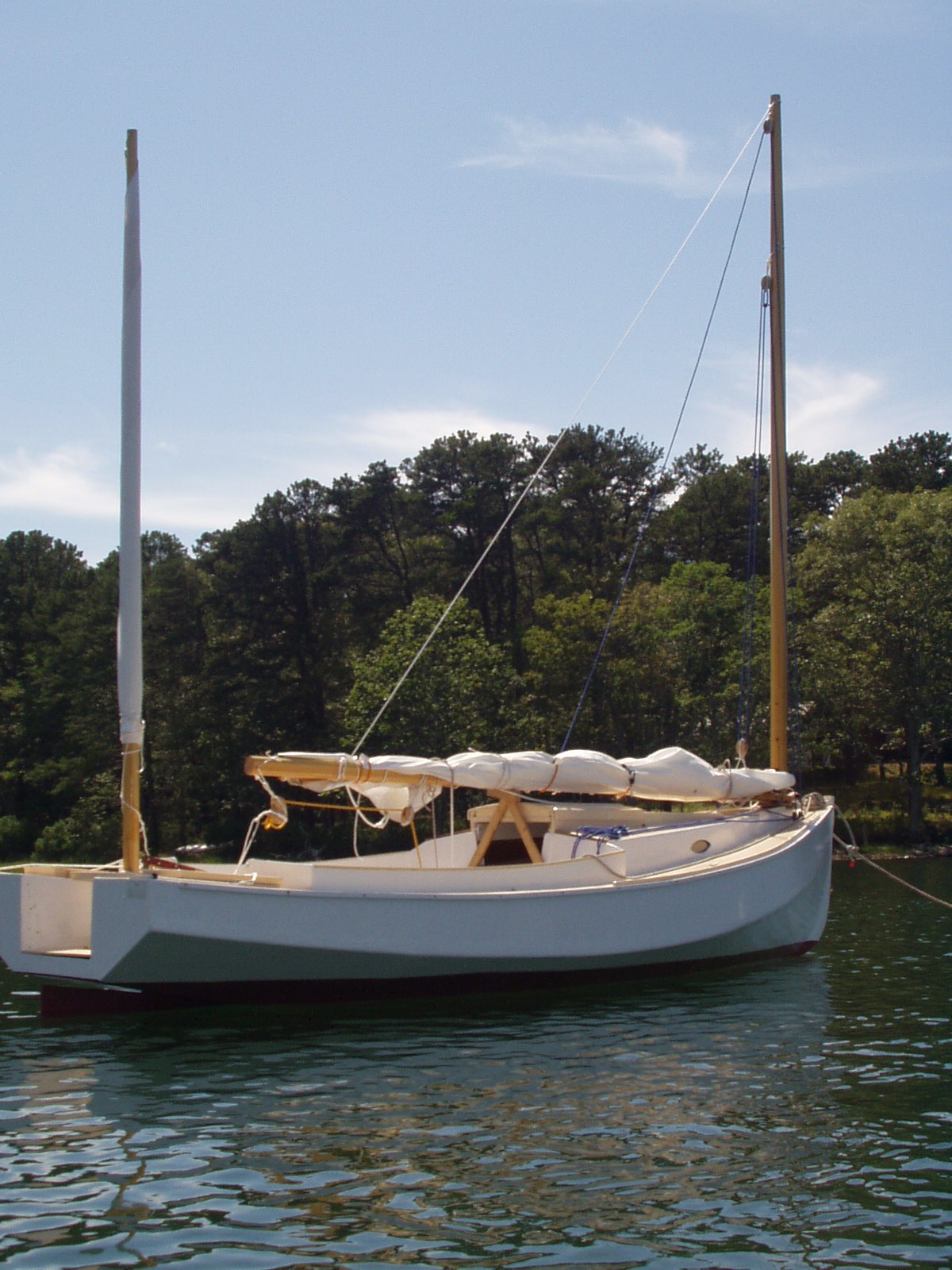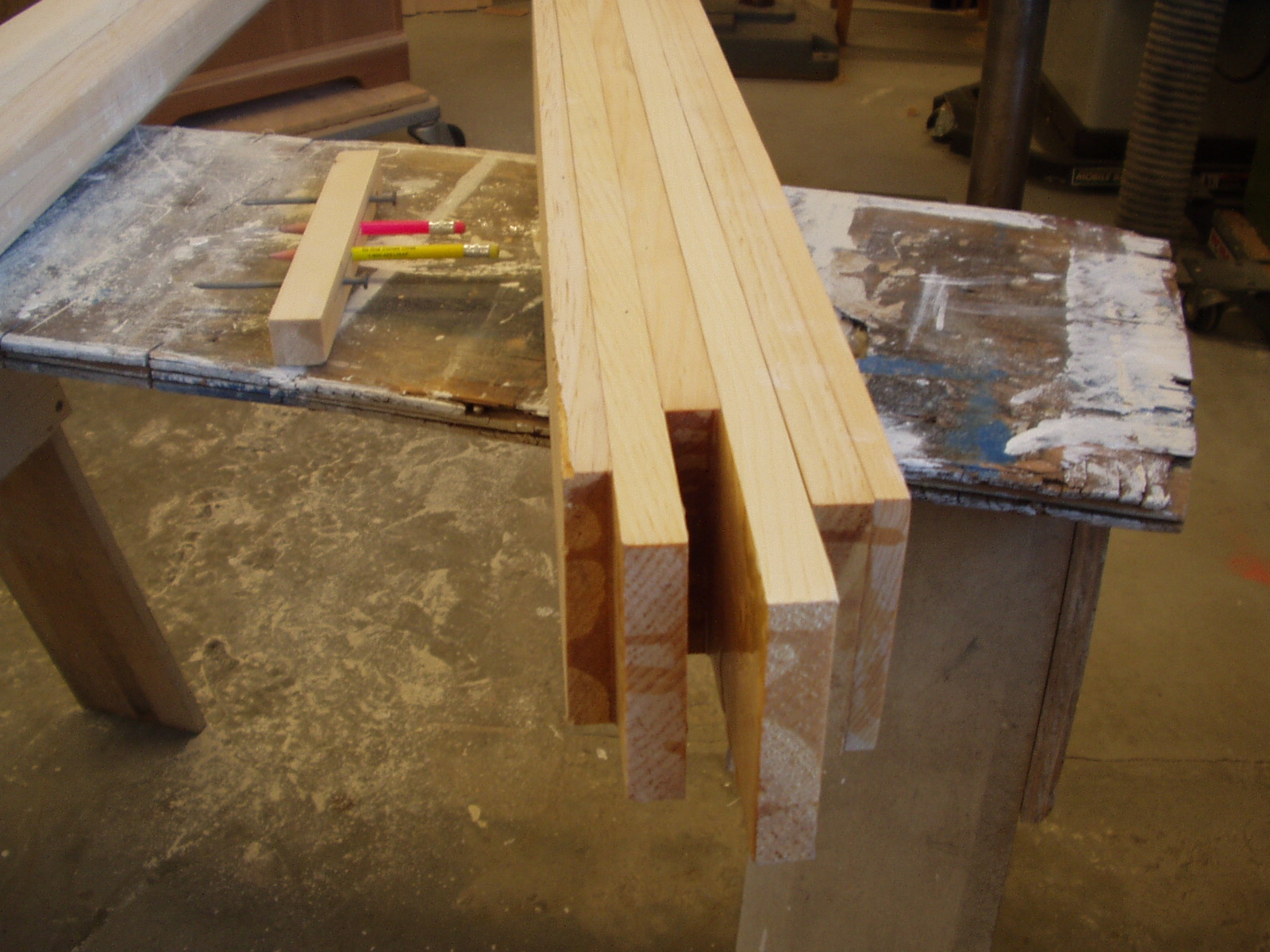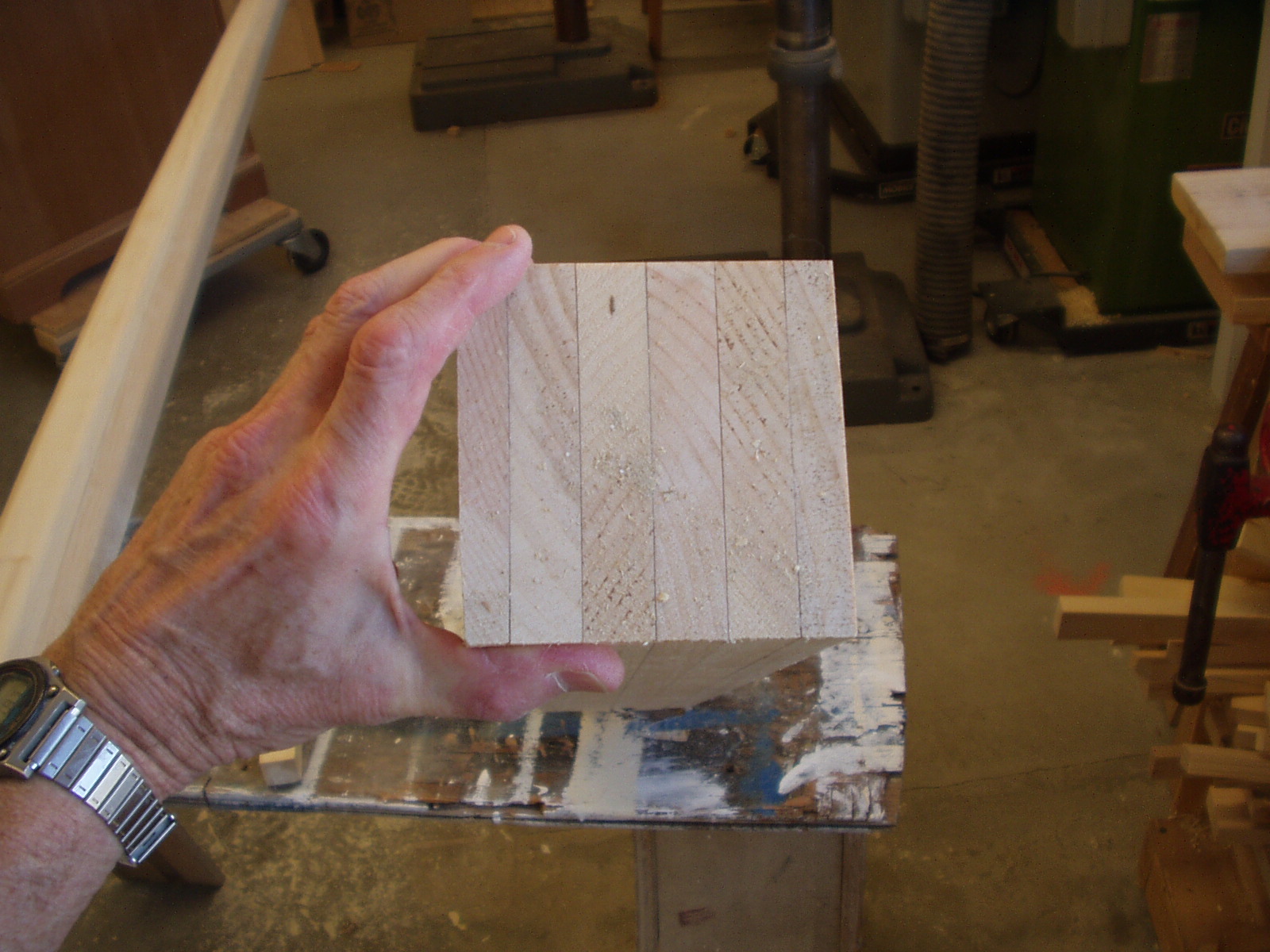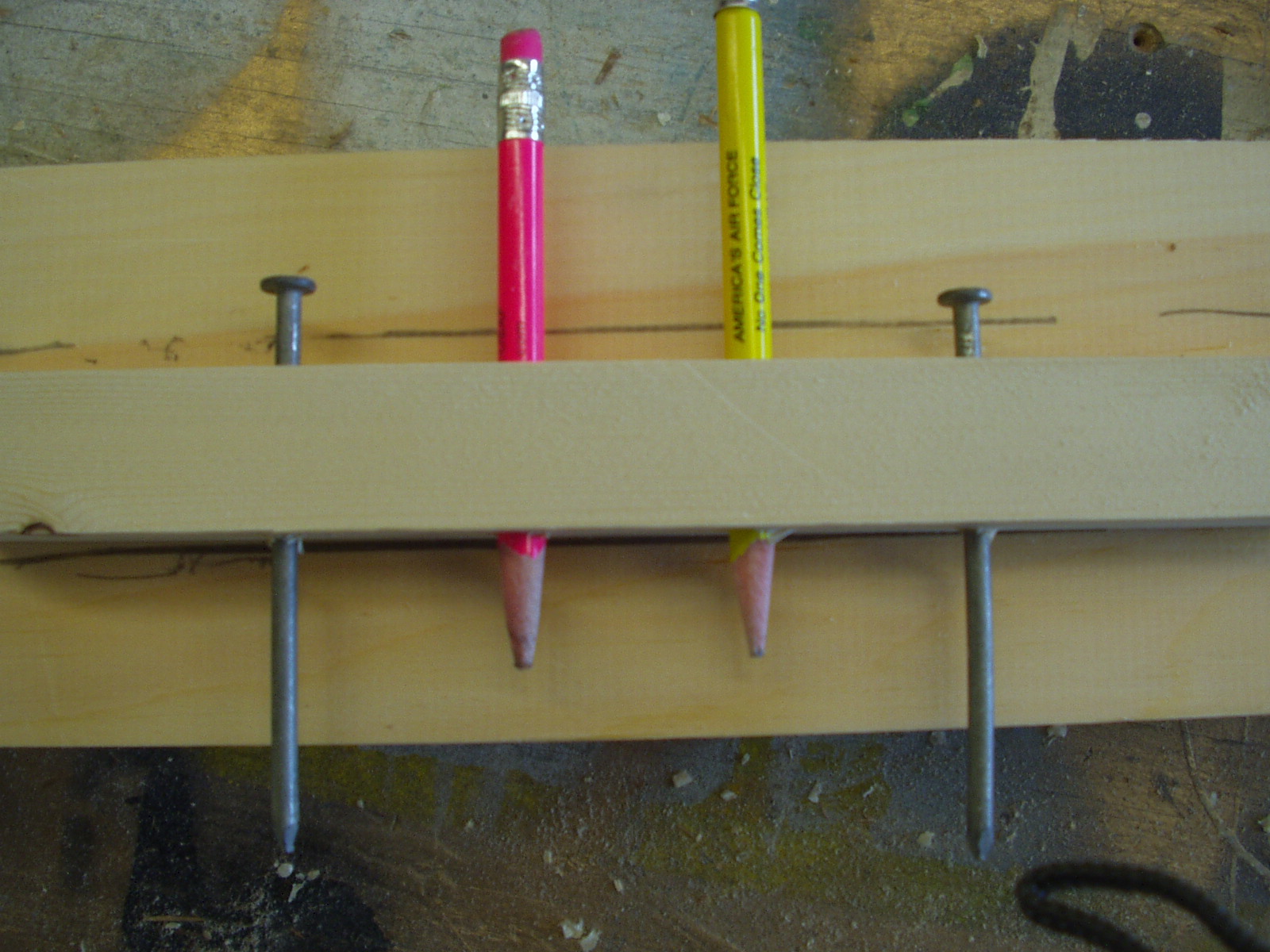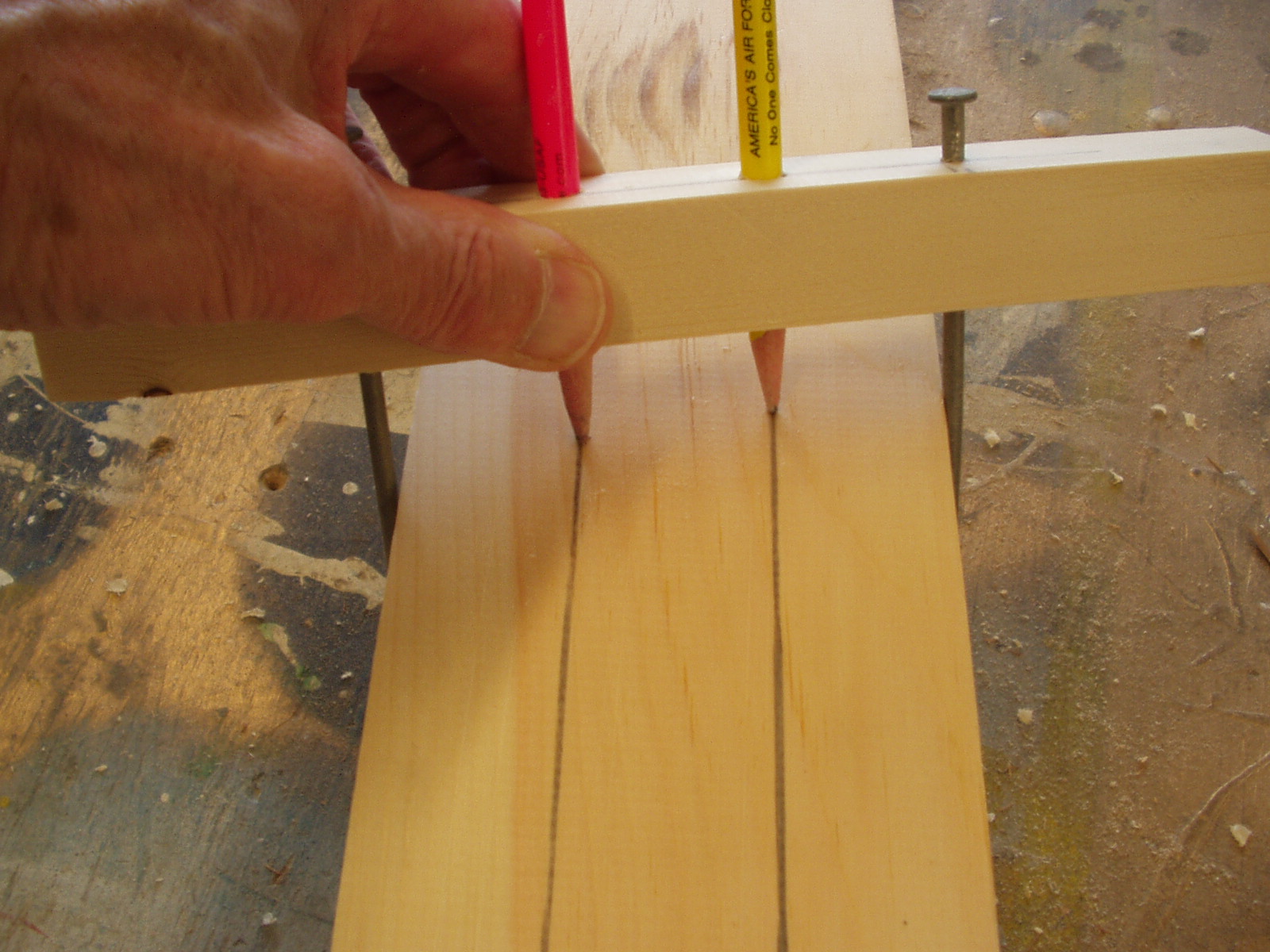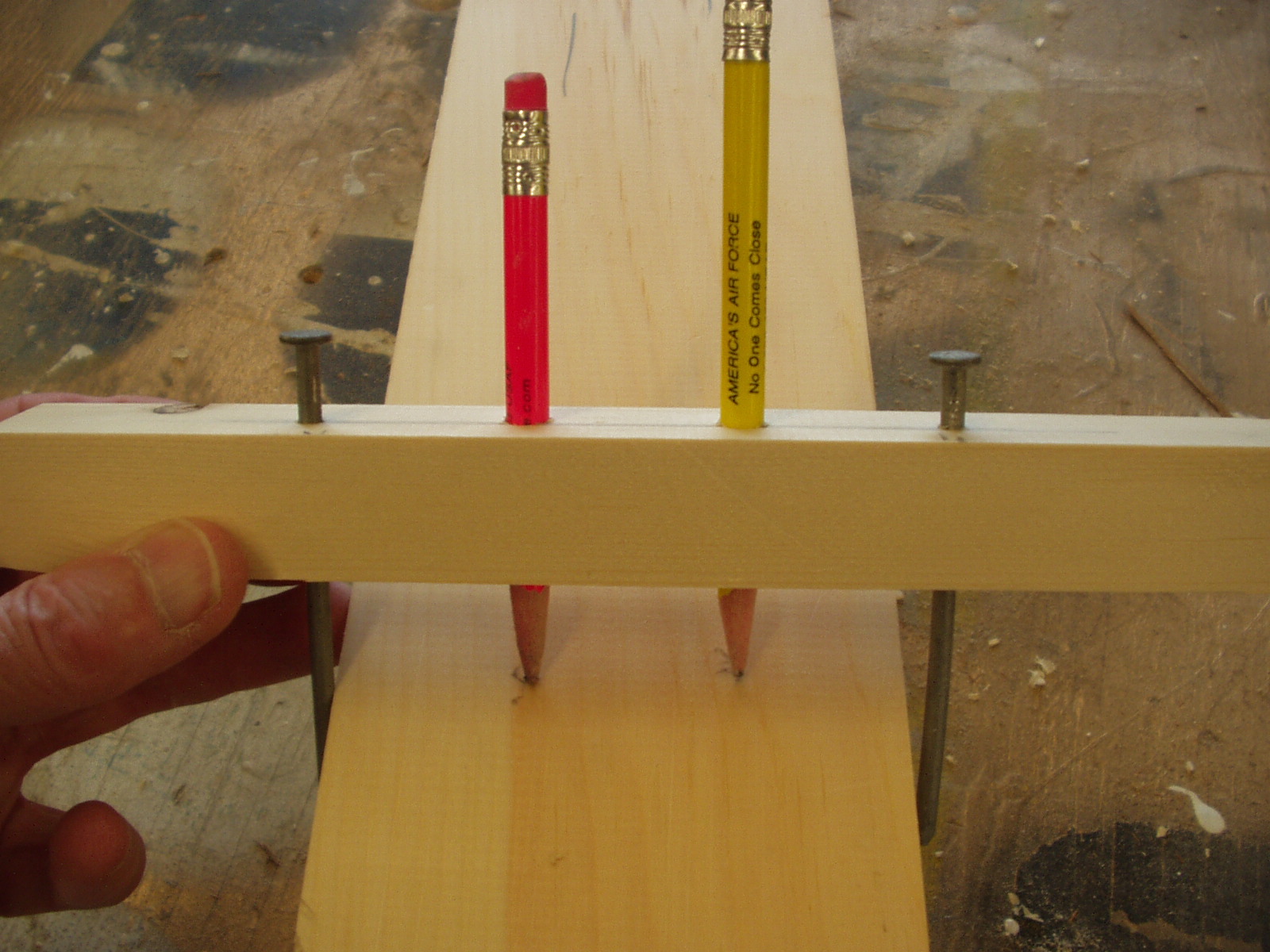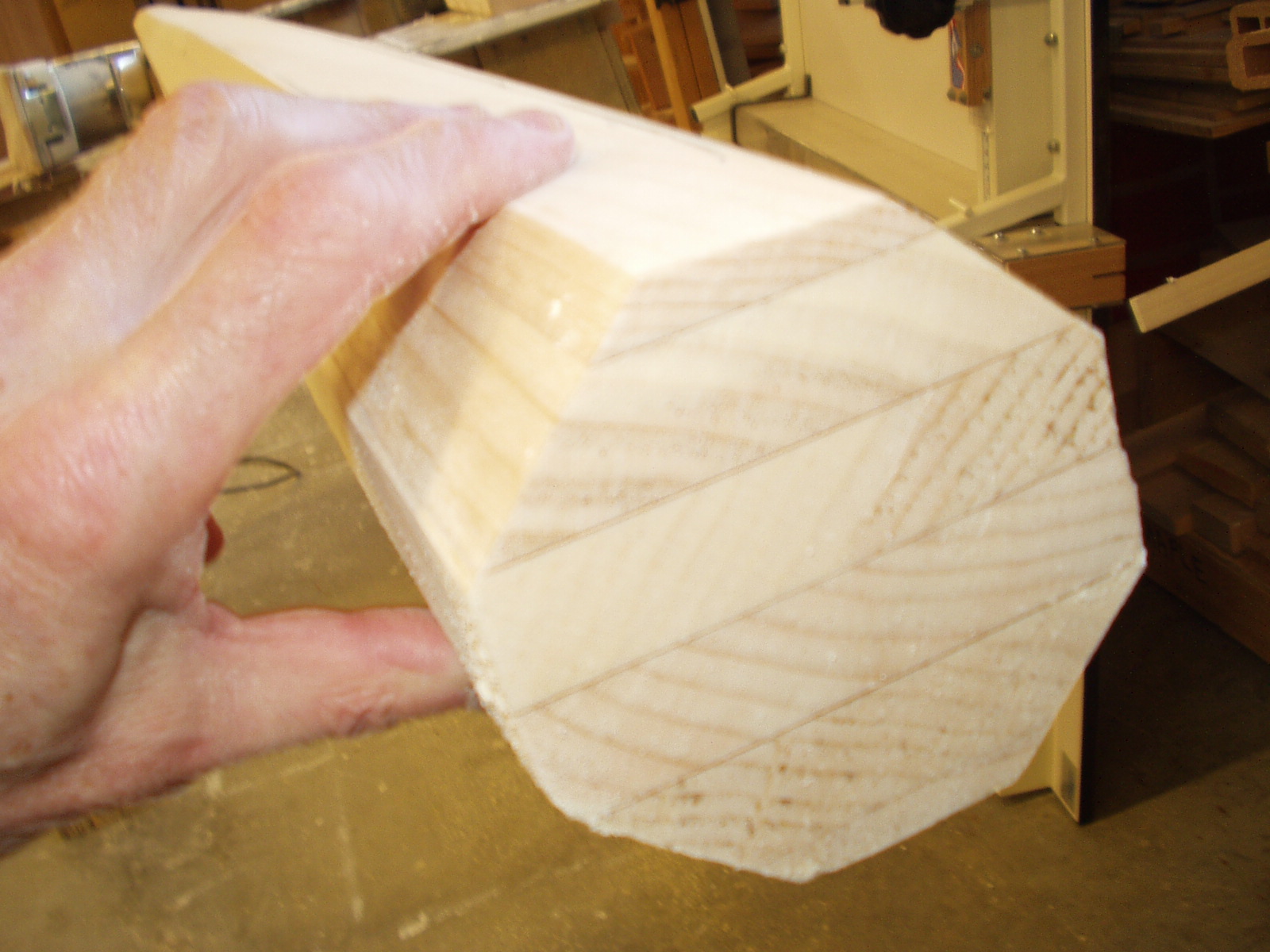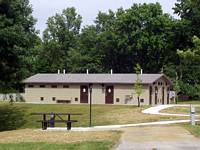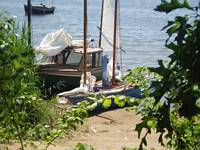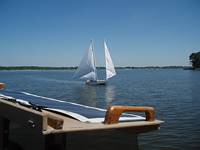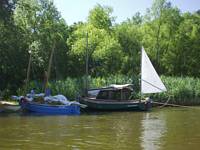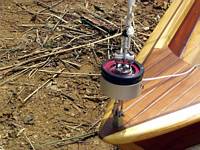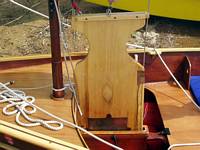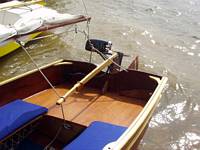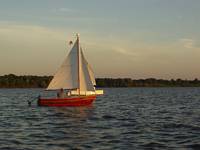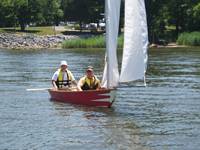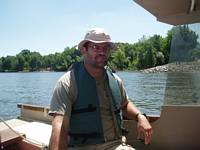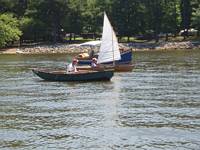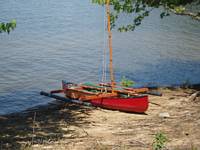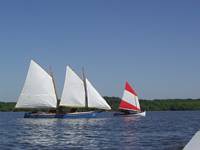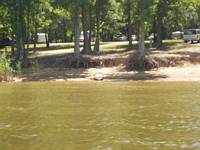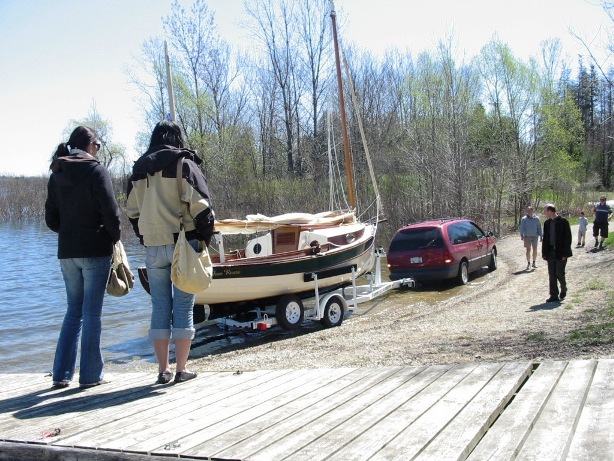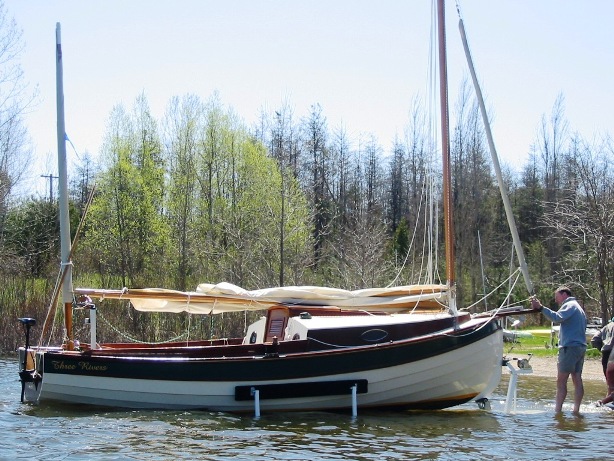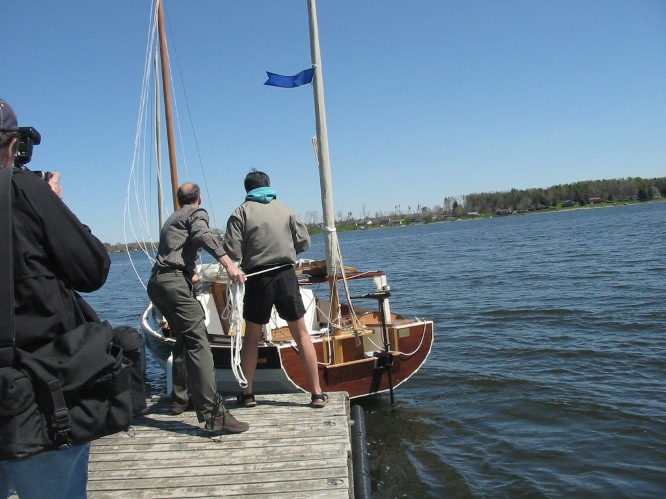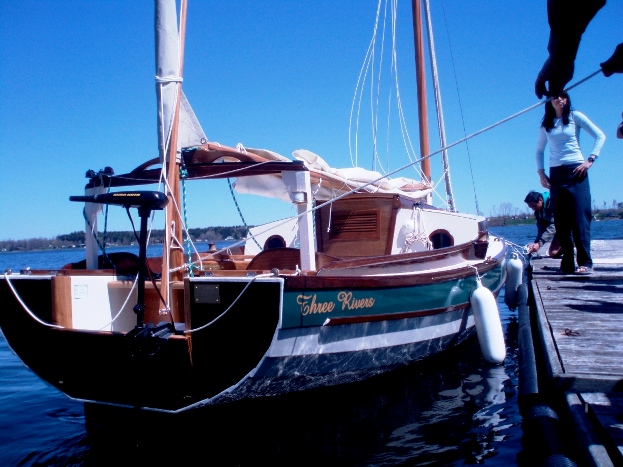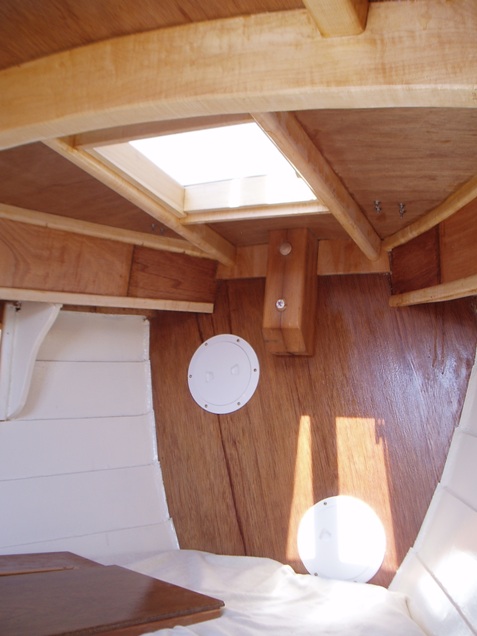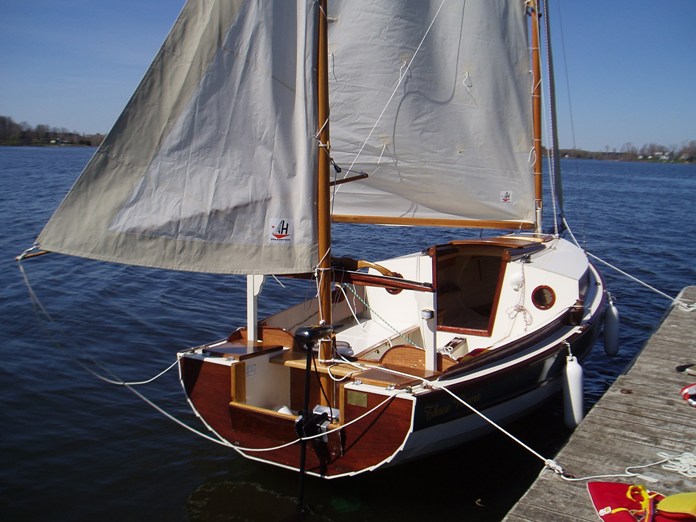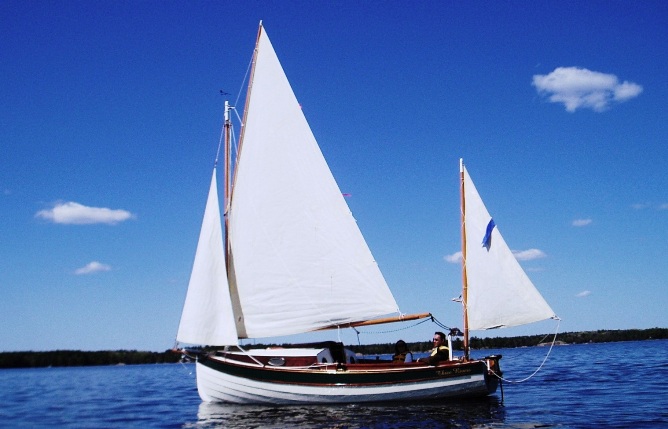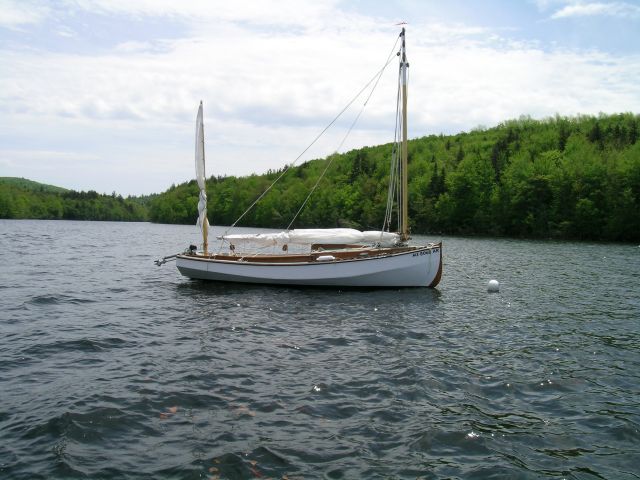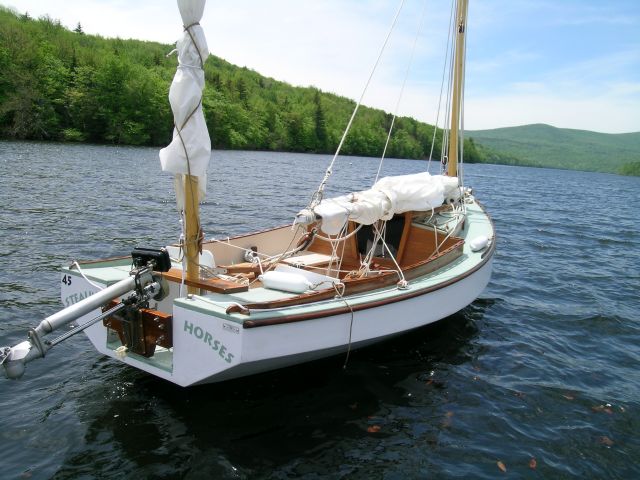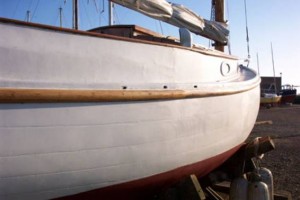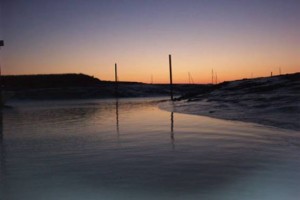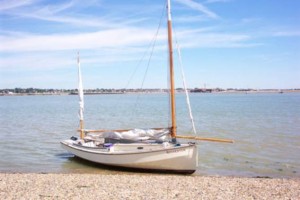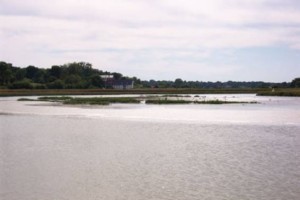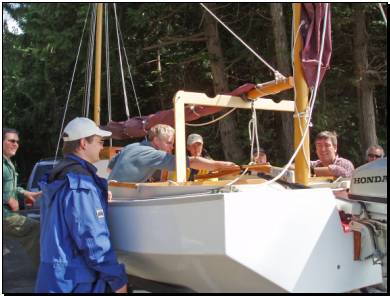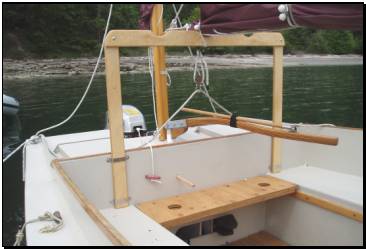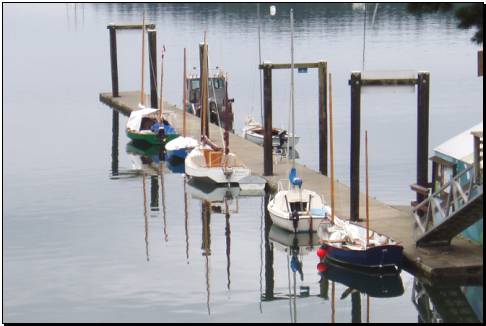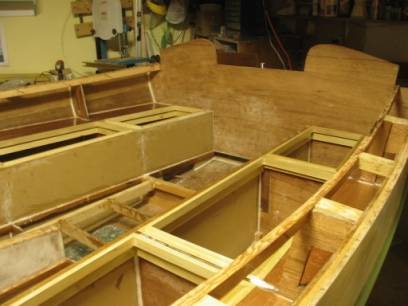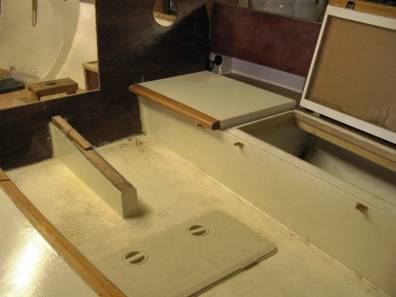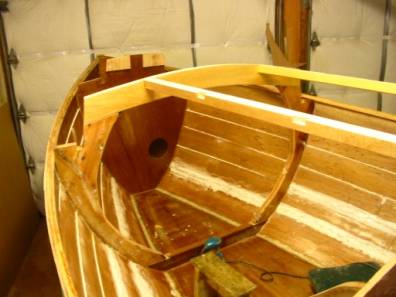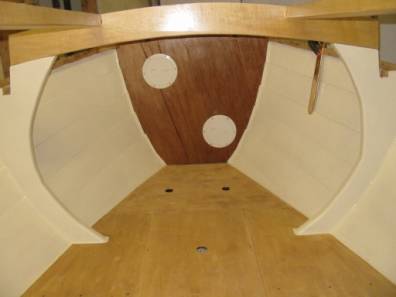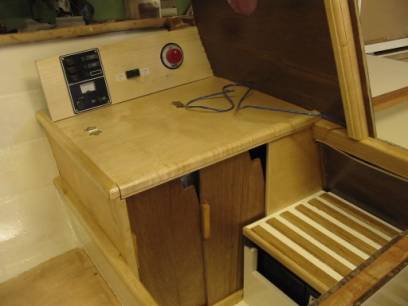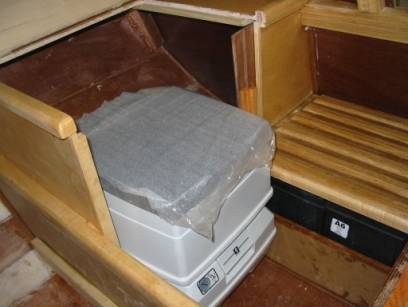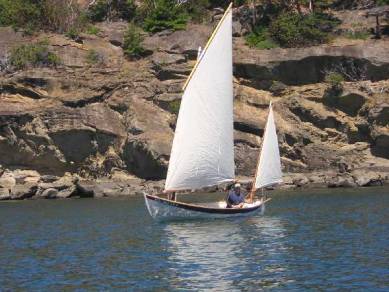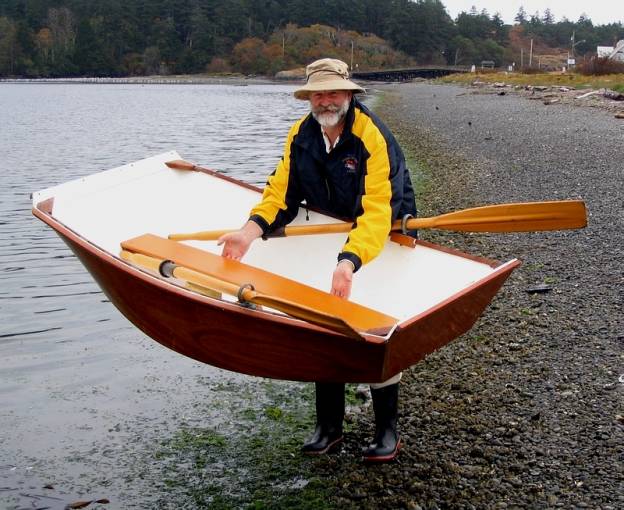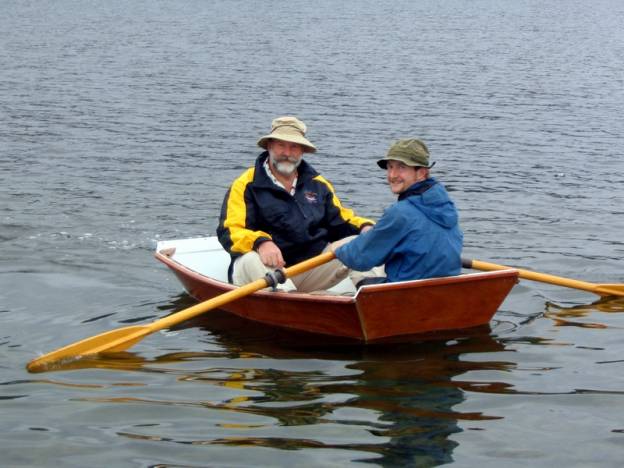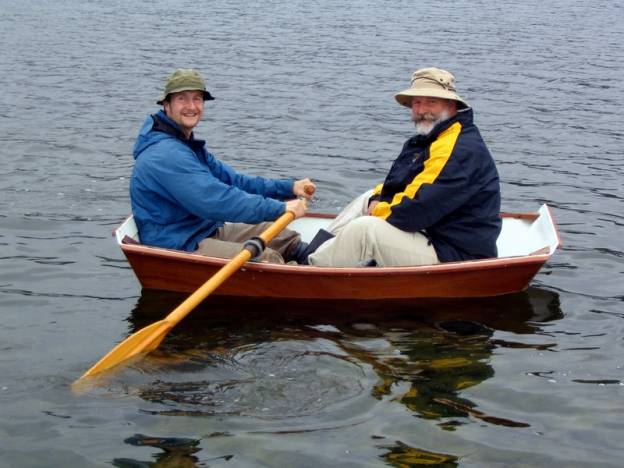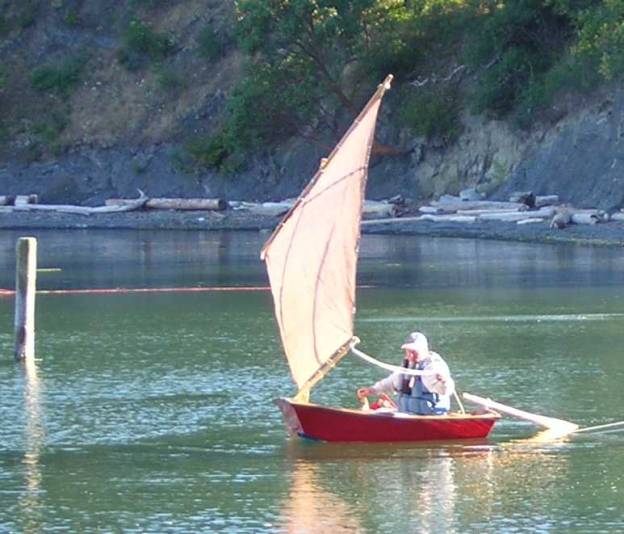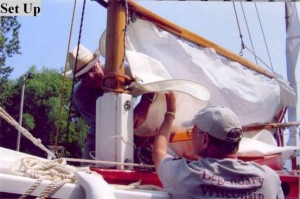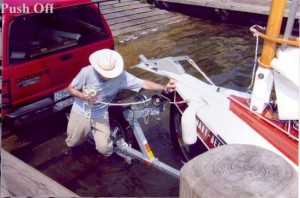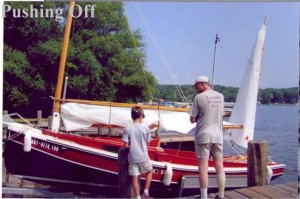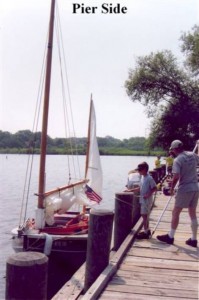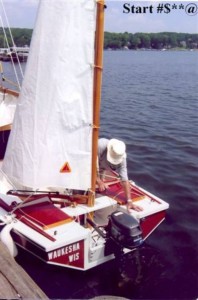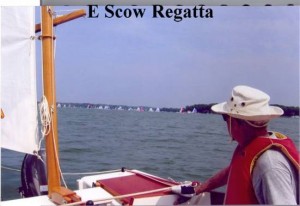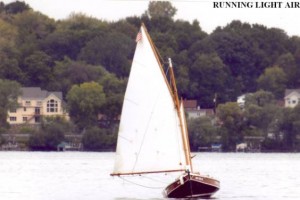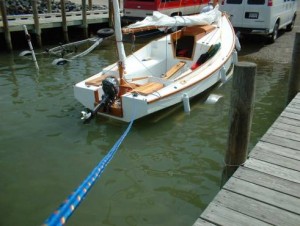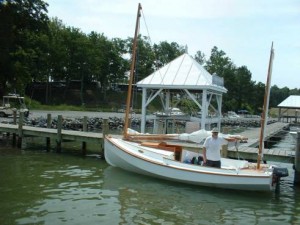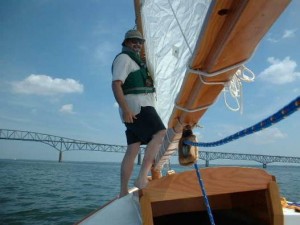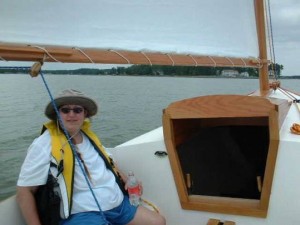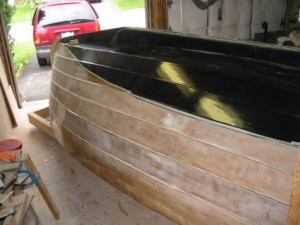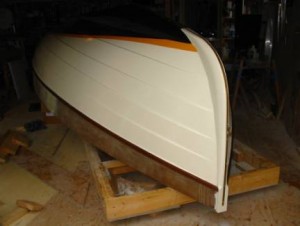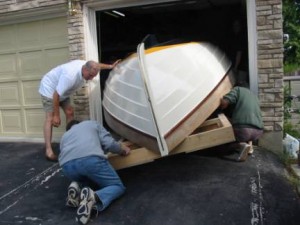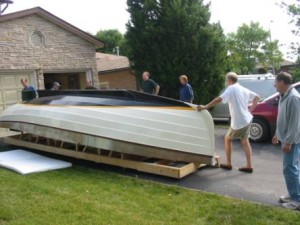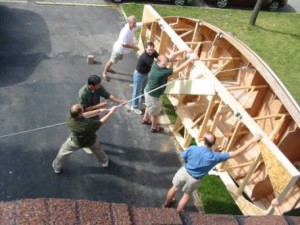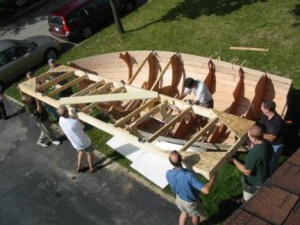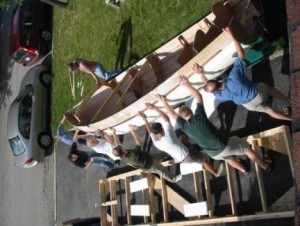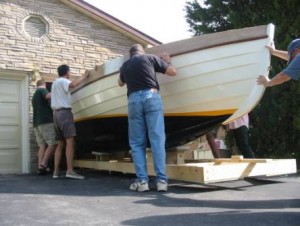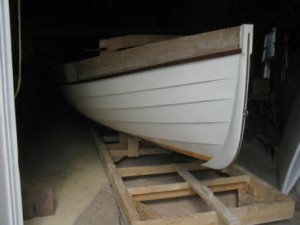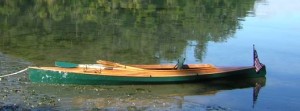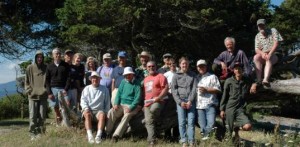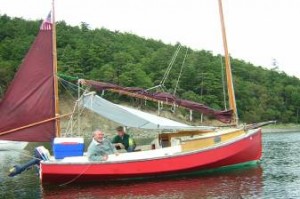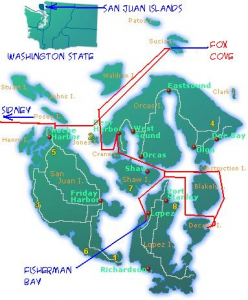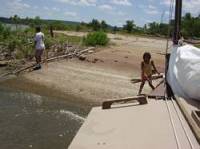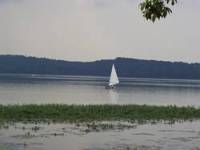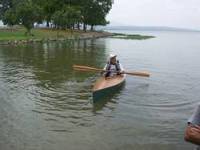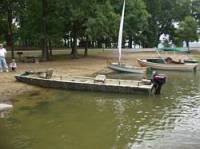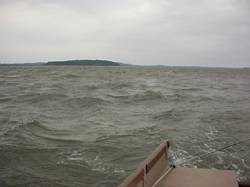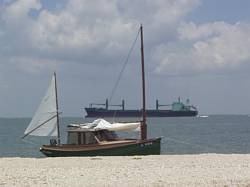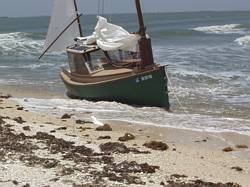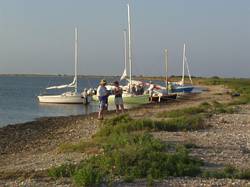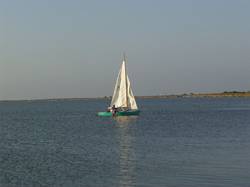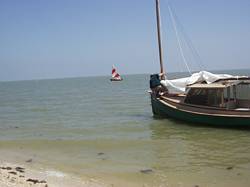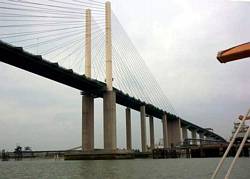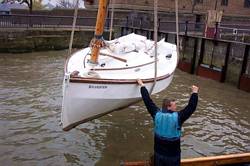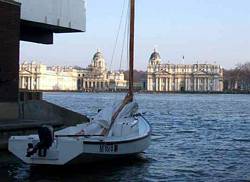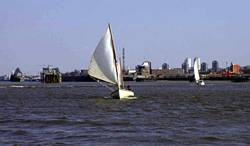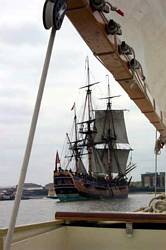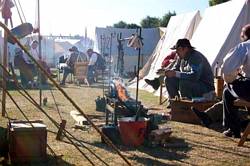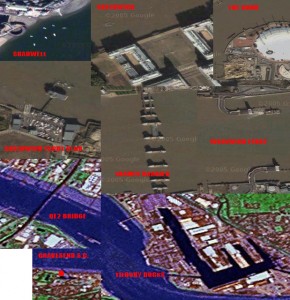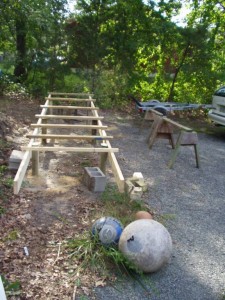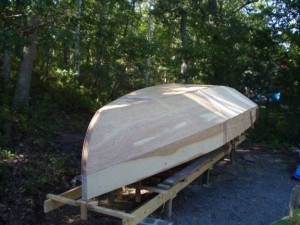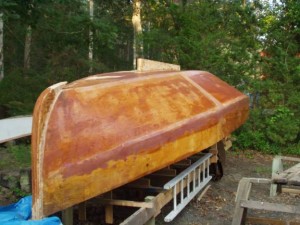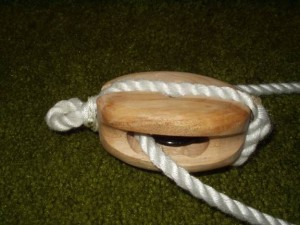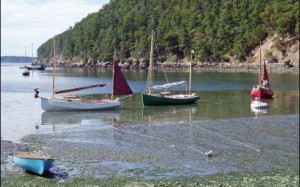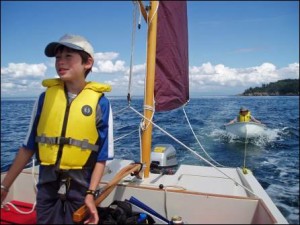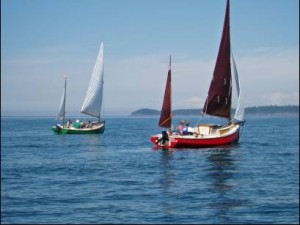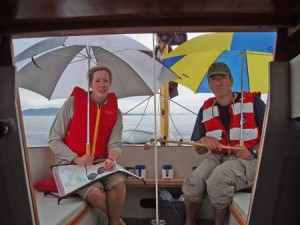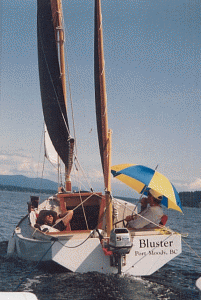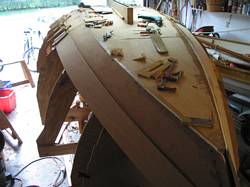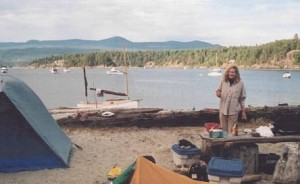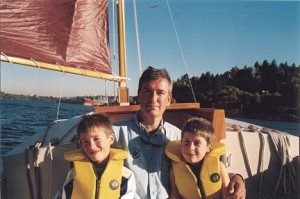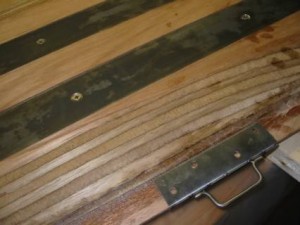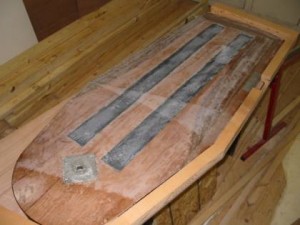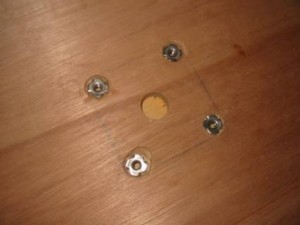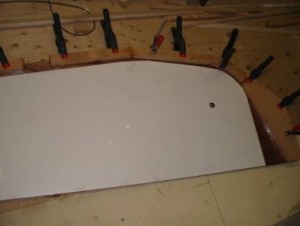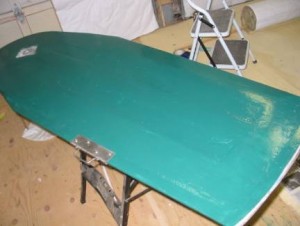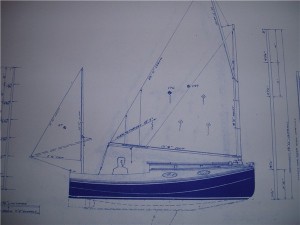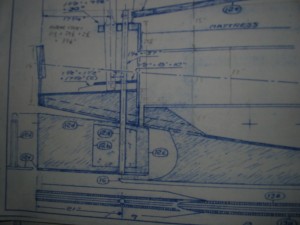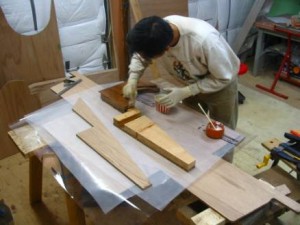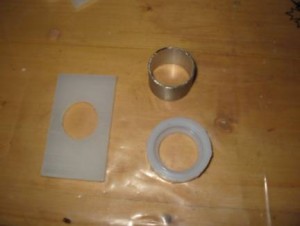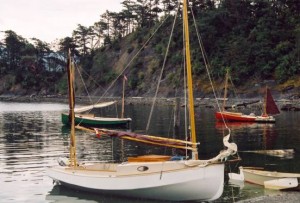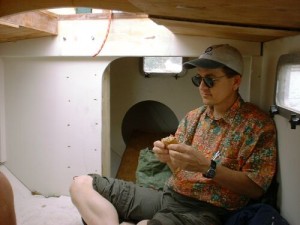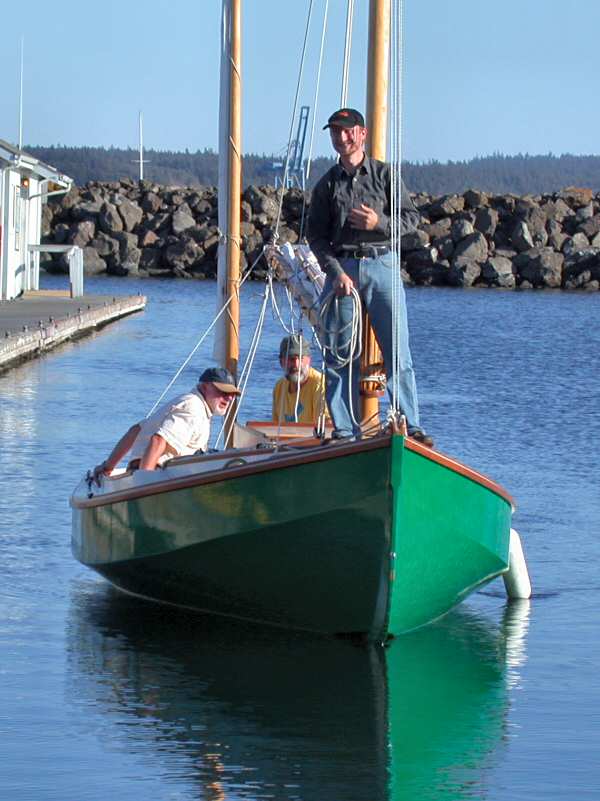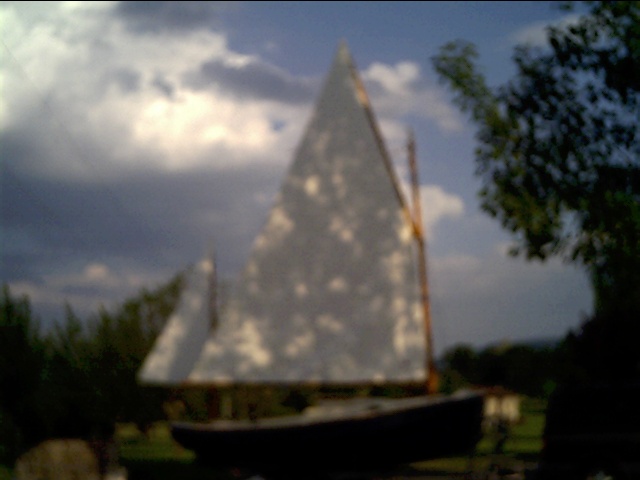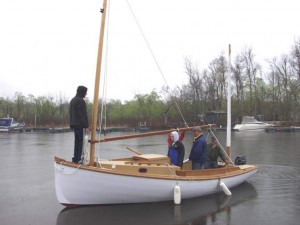News, questions, and boats for sale.
News:
| Chebacco calendars are here! I’ve worked out a “print to order” deal with a retired printer friend, so delivery will take a couple days beyond the mailing delay. Price is $20. Standard offer extended, if I use your picture in the calendar, you get one at my cost.
—————————————————————————————
For those of you waiting for the next installment of “Samantha”, Paul says he can’t make the deadline for this issue, but will try for the next one.
|
Questions:
Richard
Thanks for the great work on the new issue. Honest, I WILL get you an article on my boat, I will, I will. I read the request from Ben regarding the larger cabin. This seems to be a popular option, including on mine (tentatively ‘Tabby II’). Since there’s no address, I thought I’d forward to you. I decided to modify mine once it was turned over. With the molds out of the cabin, I decided that the head space was just too small for comfort. Unfortunately, the molds were already cut, so I had to ‘dummy up’ the expansion. I spliced in plywood on the bulkheads expanding the width out to the coaming, which allowed the framing to run continuously from the bow to stern, and raised the roof line 3″ in the back and 2″ at the front of the cabin. All the plywood was simply fitted and ‘patched’ with an overlapping layer, epoxied in place.
These changes required a bit of scratching about to arrive at the lines for the cabin sides (no interior molds anymore, remember?). Lots of string, straightedges, and bent plywood resulted in the desired taller and ‘canted’ cabin sides (15 degrees). Roof was laminated from two 1/4″ layers, a bit complicated but minimizing the stress and deflection of the somewhat light roof framing. Because the raised roof could potentially stress the mast partners a bit over the initial design, I added liberal reinforcing to that area, which should be bomb-proof by now.
Some of the other mods I added include a raised cockpit floor to facilitate draining thru the motor well area (no thru-hulls) and a plastic, pre-fab hatch to access the area under the cockpit floor. I also added a bridgedeck extending to the rear of the centerboard trunk, with one side accessible from the cockpit, and the other from below (I cut away part of the bulkhead and reinforced the area. The seats are curved to pick up the curve of the seat backs, and I cut out panels for accessing the under seat area. These (along with the bridgedeck access) will be secured and rubber-stripped for watertightness, as well as having little rain gutters built in, draining into the cockpit and out the back. The result of these mods is a huge increase in secure storage areas: under floor, under seat, and in the bridge deck (both
inside and outside access).
Few other mods worth mentioning, or that haven’t been done better by others.
I added two nice oak mooring bitts, which will support a bowsprit for a jib I’ll experiment with later. Sailrite did the sails in tanbark, and Honda will provide the power. I intend to rig ‘cost effectively’ with sand-cast bronze blocks secured with marline wraps – strong, cheap, and good looking. Plus, you can fix it with your pocket knife, anywhere.
I used lots of recycled lumber, including a load of mahogany pallet lumber I found years ago and have had laying around. I drill and plug the nail holes with bungs, and it looks OK, and, always remember, free is a very good price. Spars will come out of some gorgeous 20′ long clear fir 2×10’s that came off a church demolition as fascia boards. This stuff was seasoned and dry before I was born.
Must run. Thanks again for the great work. I’ll get some pix and words to ya soon, including some info on our (along with Jamie Orr) planned ‘Sucia Island Sail-In’ in the San Juans July 10 of this year. We hope to have at LEAST 3 Chebaccos – Orr, Wheating, and hopefully mine.
Chuck Gottfried
Fall Creek, Oregon |
Chebacco’s for sale:
|
Hi Richard, My Chebacco Motorsailer is for sale -It was shown in
Chebacco news # 17 and 25 , built in 1997 and has had very little use so it looks
like new and is available with or without motor and trailer. Price for boat
alone is 7500.00
Thanks, Bob Cushing rbrtbobcat@aol.com 315-687-6776 located in
Cazenovia, n.y. |
| How’s it going? I wanted to let folks know about my decision to sell my Chebacco. I really love this Catboat but I love my girlfriend more and want to pursue that a while. The boat is built exactly to Phil’s Specs. The trailer was purchased new for $1,300 a couple of years ago and the 1997 Force five hp. Outboard was purchased new for $800 as well (it sat on the showroom a long time I guess). The sails were purchased as a kit from sail-rite, the mainsail being sewn by a professional, and the mizzen sewn by me since it was small and manageable. I launched this boat for the first time in April of this year and have taken one two week trip and several small day trips so far. There are a few normal scratches on the hull and the spars but nothing out of the ordinary. The hull is planked in Douglas Fir Marine plywood and the floors and roof framing are Douglas Fir. There are a couple of floors made of Southern Yellow Pine and the trim is all White and Red Oak. The sliding hatch was cold molded and then veneered on the inside and out with White Oak as were the drop boards – no sign of wear on any of these components. All trim and spar varnish was Epifanes WoodFinish Gloss and it shows.
Bill Samson listed his for 4,500 lbs. Sterling which is approximately $6,500 I think. I would like to ask $6,500 to start and see what happens.
Thanks Richard.
Pete Respess
Hopewell, VA |
|
***
Strait of Juan de Fuca – Jamie Orr
Hi Richard
I was about to email you to see when your deadline was, and bingo! Found a brand new Chebacco page on the web. Good to see activity from other builders. Sorry to hear about your job problems, but I’m sure a new opportunity will appear soon, I can’t see you sitting still for long.
Always nice to see a picture of Wayward Lass front and centre, but I wonder if you could make a small fix. Chris probably didn’t know, and I missed it, but we should have given John Kohnen photo credit for the picture of WL arriving in Port Townsend. John is the man behind the “Mother of All Maritime Links”, and provides pictures for many of us at local events. He lets us use his pictures freely, so it’s only right to recognize him when we go public. Can you add something like “photo by John Kohnen” to the page?
Come to think of it, John would make the subject for a good small boat article — have to give that more thought. Meanwhile, going back to my opening remark, I have a write-up of sailing in Sylvester, Bill Samson’s old Chebacco, on the Thames River at the end of January. I dawdled in writing it, and I’ve missed this issue, but I’ll send it along shortly — might as well polish it a bit more, now.
And just for the hell of it, here’s the latest picture of Wayward Lass, taken in the Strait of Juan de Fuca looking south to the Olympic mountains in Washington State. Don’t expect you to publish this one, I’m just showing off our local scenery. Got it from a stranger who was photographing a kite-surfing event — saw him pointing his camera our way so when I saw him later at the ramp I asked if he had any good ones of WL. He emailed several, I like this one the best.
Cheers, and I’ll get that article in soon.
Jamie

***
Sylvester goes to London – Jamie Orr
January 31st, London, England. I’m standing outside my hotel, about to be picked up by someone I’ve never met who will take me to a boat that would have been laid up by now, except that its hauling-out has been delayed just so that I can go sailing!
Sound a little unusual? Not at all, not to a Chebacco sailor! Richard Elkan is the new owner of Sylvester, built by Bill Samson up in Dundee, Scotland. When I emailed Richard to say I’d be in London and could we meet, he immediately offered a days sailing, even though he had planned to have Sylvester out of the water for the winter by then. Another example of a friendly and hospitable Chebacco sailor! (This was to be my second time in Sylvester – I first saw her (him?) in Dundee in 1999 when owned by Bill.)
Richard was right on time, and off we went to the Shadwell Docks, one of the oldest docks in London. It’s no longer used for commercial shipping, but is home to a large and active sailing/kayaking group (see their website at http://www.shadwell-basin.org.uk). There is good size basin for small boats and training, and since the river is tidal at Shadwell, it is protected by a set of locks, like a canal.
While we waited for Graham, the third member of the crew, Richard tested an elderly Seagull outboard motor – it hadn’t run for a while, and took a few pulls, but nonetheless rasped into life. Must be true, what Seagull folks say about their engines! Graham arrived about then, so off we went.
Sylvester lives on a mooring in the river itself.

Since the wind was howling down the river and kicking up a good chop, Richard thought it best if he and Graham went out to the boat in the dinghy, then picked me up from the beach – a gravely strip along the edge of the river.
It didn’t take them long to strip off the cover, raise the sails (with both reefs firmly tied in) and cast off the mooring. Sylvester fell off on the starboard tack, flew away to the other side of the river then back towards me and the beach.

Richard stopped her, head to wind in about a foot of water, I jumped in and she shot away again.
As I said before, the wind was coming down the river, about 20 knots worth, at least. As well, the tide was ebbing, adding its strength to the river’s current. Richard had planned to take the ebb tide down towards Gravesend then come back on the flood, but given the strength of the wind, we decided to start off upriver/upwind to be sure of getting back again. And what a sail it was. Even with both reefs, we had to pay strict attention, luffing through the gusts. Soon after we set out Richard handed me the tiller and I started a new chapter in my sailing career. Not only did I have to keep us upright, but also make what progress I could up the river, tacking every minute or two and keeping a sharp eye out for other river traffic – including cruising restaurants!

I didn’t have to worry about the mizzen, which was a big help, as Graham handled that throughout.

The banks of the river are lined with wharves, pilings and moored boats, and the tourist boats go up and down in a never ending stream. This was on the last day of January — I dread to think what it must be like in summer! I don’t think I disgraced myself, but after each tack to the other side and back, my progress could be measured in inches. So I took the easy way out and gave the helm back to Richard, saying I wanted to capture the experience on my new digital camera. He showed me how it ought to be done, routinely leaning Sylvester over farther than I’ve ever had my own Wayward Lass – well, maybe I was that far once, but I thought I was going over that time!
I was quite impressed with how Richard and Graham worked as a team to gradually bring us up to the bend in the river where I could finally see Tower Bridge.

However, that was our limit for the day, and it had taken two hours to come perhaps half a mile up the river! We turned around and zig-zagged back down, so we could reach instead of run. In a very few minutes we were turning into the wind with sails flogging so I could step off onto my beach again. Sylvester was off on the instant, and was halfway across the river before I had waded ashore.

When Sylvester was moored again and the guys had joined me ashore, Graham said goodbye – it was his birthday and his family were waiting for him to come home so they could start the party! Richard showed me a few of the sights along the Thames, we even drove under the river (which is new since when I last drove in London.) We stopped at a boatyard where someone is finishing a Nigel Irens Romilly, but unfortunately the yard was closed and we couldn’t see the boat. It’ll be interesting to see how Romilly compares to the Chebacco – roughly the same size, accommodation and even a similar rig, at least superficially. Big difference in cost, though.
After a while, Richard noticed that the river hadn’t risen since we came ashore, so he phoned the local authority that measures these things. They told him it hadn’t risen for three hours, although it should have. The wind was strong enough to hold back the tide! Good thing we didn’t go downstream, we’d still have been there!
We were just in time to see a bit of the Maritime Museum at Greenwich, this was a treat for me as Shackleton’s lifeboat, the James Caird, is on display there. I snapped a picture before I saw the sign saying “no photographs”, but I’d probably have broken the rules anyway, Shackleton is one of my heroes.

Standing with my hand on the Caird’s gunwale, I couldn’t imagine what it must have been like for the men who sailed her from Antarctica to South Georgia. And how did they find their way? I have trouble getting a decent sextant reading when I’m standing on dry land, never mind bouncing around in a 20 foot boat. Giants indeed.
Closing time arrived far too soon, and we had to leave. Our next stop was the nearby Greenwich Observatory, where we took pictures of each other astride the Prime Meridian. (It’s painted on the sidewalk!) However, the pictures didn’t turn out very well, probably because of my lack of experience with the camera, so I can’t show them to you. You’ll have to visit and see it for yourself. When we went back to the car, we found we were locked in, but someone arriving for the night shift kindly let us out! We finished the evening at Richard’s where his wife served us up an excellent dinner. I stayed later than I probably should have, but was enjoying myself too much to leave.
When I finally pulled myself away, Richard walked me down to the local station, and I caught the Underground back to my hotel – amazingly good train system, every city should have one just like it. And that was the end of a truly wonderful day. My heartfelt thanks to Richard, and Graham, for it.
Richard hauled Sylvester the following week, for painting and other work. He sent this picture of her when she went back in the water, he’s done a really nice job.

***
Chebacco scale model – Ben Ho
Hello Richard,
I have completed my 16:1 scale model for the lapstrake Chebacco I am planning to build. It’s a very useful exercise for me and well worth the time spent. Attached are a couple of pictures:
1. The strong-back and the molds have been set up, bottom in place. To help level up the molds and to hold them in alignment, I over-lay all the molds
on the body plan, align them longitudinally, drill two holes through them, and used bamboo skewers as the alignment rod.

2. The laps were glued on one by one, held in place with a combination of elastics, masking tape, and clothes pin. The laps and decks are made of 1/16
maple veneer which is very easy to work with. Wish the real thing will be as easy!

3. The completed model. I’ve enlarged the cabin slightly. The model has served the purpose of validating the offsets, molds, and construction steps. I think I will leave out the spars.
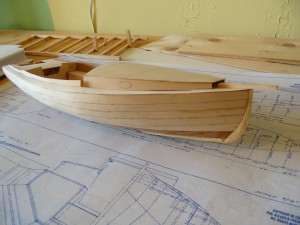
Cheers
***
Some photos – Dave Neder
Good Afternoon Richard
Attached are some photos I took while getting ready for sailing this year.

I installed the wedge shaped removable bunks to support the stern. Because of the shape of the rudder, the stern overhangs the trailer. It seems to ride OK without any strain on the boat. Barrel bolts prevent the wedges from sliding out while travelling.

The Motor detail shows the chain/turnbuckle system to keep the motor centered when using the motor. The eye bolts holding the turnbuckles
are offset so that the chain/turnbuckles relax when the motor is tipped up for sailing. The remote control cable run thru a water tight fitting in the motor
well wall. The motor controls are mounted on the starboard cockpit wall.
Getting ready for the road shows the 5HP Nissan. The mizzen is set ready to tip the mast.

The truck (work horse) has carrier bars attached to the truck cap. If I am going to use Mary Beth,too as a motorboat, I store the unneeded spars on the carrier bars. For traveling on the highway the spars are stored on the white saddles and covered with a boat cover.

I am thinking about adding a jib. I would like to contact Fraser Howell for locations of sheet block and other dimensions and any help he might offer.
Regards
Dave Neder
***
The Building of Johanna, A Chebacco on Steroids – Michael Johannessen
Richard,
Thanks for keeping the Chebacco news alive.
I hope you like the story and feel free to use as you wish.
Would it be OK to register it on your site?
I also hope you gain employment soon.
Regards
Michael Johannessen
Melbourne
Australia
———–
Having harbored a desire to build a proper boat for some time, I satisfied the itch by reading home built articles for a number of years.
However the itch got worse and had to be cured. I have built lightweight racing dinghies in the past and I just had to build another but bigger and
more comfortable boat as I get older.
I wanted a boat capable of good seaworthiness in sheltered and coastal waters, reasonable sailing and motoring performance with accommodation for
my wife and I for up to a week. As we plan to cruise rivers and lakes, A shallow draft design was mandatory.
I was seeking a design that had modern features but with strong links to the past, particularly the North East USA Catboat, the traditional English
sailing craft as well as the local Couta boats here in Australia.
The Phil Bolger designed “Chebacco” was selected as a prime candidate and after discovering on the internet “The Chebacco Newsletters” edited by Bill
Sampson, I was provided with the necessary inspiration and confidence. A visit was made to Duck Flat Wooden Boats in Adelaide where the plans for the
sheet ply version of Chebacco were ordered.
The Chebacco is a very pretty boat but the 19’6″ length was a little shorter than I wanted, the accommodation limited and I liked the look of the lapstrake hull.
Mr Bolger’s sweet lines were keyed into the Vacanti Prolines Hull Shape and Stability Software package and the hull expanded till the beam was at the maximum towing road width of 2.4Metres. The overall length turned out to be 6.3Metres.
To develop the planked lapstrake hull shape, the second chine was removed in the software and the underwater shape adjusted until the original waterline was met. The total displacement increased by approximately 100kg to 900kg when fully laden. No specific inclusion for ballast was made.
A generic CAD package was used to convert the Prolines offsets to a set of construction plans.
Other modifications to the design included a solid keel, sealed cockpit and cabin floors and increasing the cabin size.
The boat was built from plywood with all external areas sheathed in either glass of dynal. Polyurethane paint was used over an epoxy undercoat to minimize ongoing maintenance needs.
The boat was built the right way up using the 16mm plywood bottom of the boat is a solid foundation for attaching the bulkheads, molds, transom and stem. The hull bottom jig consisted of 15 stations set at the fairbody height to firmly support the bottom of the hull during the planking phase.
The hull was constructed in three stages, firstly right way up, then upside down and finally right way up again. Lifting the boat out of the shed twice made working on the boat easier but has twice as much stress as a single turnover.
In general, the following construction sequence was followed, keel built and installed in the Hull Jig, hull bottom fitted to the keel, centreboard case fitted to hull bottom, transom installed, female molds installed, hull planked and bulkheads/inwhales installed.
Half a dozen of my Yacht Club mates helped turned over the hull. A low key first turnover party held.
The next phase of fairing, sheathing and painting of the outside hull was a most boring, messy and demanding. Building a lapstrake boat is a once in a lifetime experience. Turnover party two was a major milestone as the next time the boat emerged from the shed it would be for the launch.
The final phase of the work took the longest and included completing the hull interior, the cockpit/decking, cabin, rudder, motor and the electrical
and plumbing work.
Launching was successful and as expected the boat floats above the designed waterline until the masts and rigging are installed. In the meantime 70Kg
of lead in the bow is being used to trim the boat. With the 20HP Honda 4 Stroke on full throttle, the maximum hull speed is almost 8 knots and at 25%
throttle, the speed is 5knots.
As I will using it as both a power and sail boat, I have fitted a steering wheel to control the outboard engine when not under sail.
Like all home built boats, the estimated construction time was very optimistic. As I could only work on the boat at weekend, the one year estimate stretched to five years. Visits to your website helped during the construction.
The next project is to build the spars and turn the power boat into a sail boat – maybe in six months time.


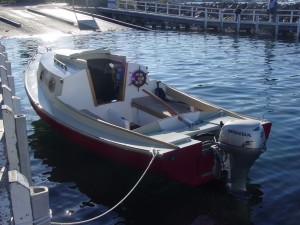
***
Wayward Lass in the Canadian Gulf Islands – Jamie Orr
Our 2004 Cruise
This year our annual cruise was in home waters instead of driving to the north end of the island. This meant I had only a 35 minute journey to Dad’s place then another 5 minutes to Tulista Park in Sidney, saving us two days on the road. We left the dock at 11:20 on Saturday morning, motoring out onto a flat calm sea. We steered slightly north of east, passing to the west of Forrest Island.

Setting out
At 11:45 a touch of wind came up from the south, so we raised the sails and motor-sailed past Domville Island, finally stopping the engine just north of Brethour Island at 12:15. It took us until 1:30 to cover the next mile, sailing slowly against the ebbing tide until we neared Fairfax Point on Moresby Island. The Current Atlas showed a weak counter-current in our favour, close in to the shore, that would give us a lift around the point and over to Pender Island, our goal for the night.
The Current Atlas lied. At 5:30 we were still trying to round Fairfax Point. We’d tried it close in to the land and we’d tried going well out from the point, but either way the little wind we had could not overcome the adverse current. At one point we crept up the shore, not tacking until our bows were practically on the beach, but although we reached the point, we could not get around it. Eventually, at 6:15, the tide weakened and we passed the point. However, it was a hollow triumph, because the wind also died away completely, leaving us drifting down Haro Strait, away from Pender.
So Honda came to the rescue, and we finished the day by motoring into Bedwell Harbour on the south side of Pender Island, and anchoring in the marine park there. The mooring buoys were all occupied, and the area around them was crowded with anchored boats, but we left them all behind, tucking ourselves into the shallows behind Skull Islet at 7:30, only a few yards from shore.

Here’s Bedwell Harbour, taken from behind Skull Islet
We first visited Skull Islet about eight years ago, when chartering in company with another family. On that occasion we took up a couple of the mooring buoys, but with small children along, we just had to row over to Skull Islet to look for buried treasure! No golden treasure, but we took away some good memories.
On this trip, we were just thankful that the rocks around the islet ensured our privacy. This was just the first of several times that we appreciated the shallow draft of a Chebacco. We put up the shelter and cooked up our supper, and by the time we’d cleaned up after it was quite dark. I pulled the inflatable out of the after locker where it lives and put it on the cabin top to pump it up, there not being enough room in the now-covered cockpit. There wasn’t really enough room up there either, but the inflatable has two main chambers, both of which go all the way around. I was able to get the first one tight enough to let me row ashore to finish the job. I did a little exploring by flashlight, then rowed back to Wayward Lass where we turned in for the night.
In the morning we had a good breakfast, fortifying ourselves for whatever the day would bring. By 9:00 there was sufficient wind coming into the harbour from the southeast that we were able to recover the anchor and sail out of our corner without using the motor. However, I have to confess that with all the rocks showing around us (it was low tide) we did start the motor and let it run in neutral while we did this. Just a bit of insurance.
Bedwell Harbour is connected to Port Browning on the other side of Pender Island by a narrow channel, crossed by a road bridge. Both Bedwell and Browning are bays that cut deeply into the island (it’s two islands actually, North and South Pender) so the channel is relatively short, but winding. Since both the wind and the tide were going our way, we thought we’d see if we could get through the passage under sail alone. We’d turned off the engine by now, and were confident enough that we left it sleeping.

The entrance, between the buoys
The channel was sheltered, and little wind followed us in. At one point we thought the wind was going to turn against us, but after one or two flaps of the mainsail, everything went back as it was and we carried on, the tip of the gaff clearing the bridge with a healthy margin.

The bridge
As we neared the end of the passage, the wind grew steadier again, until we had a good sailing breeze from the mouth of Port Browning, which faces east. Once clear, we turned and ran to the head of the bay to have a look around. The most interesting sight was what appeared to be a Viking ship. However, when we sailed closer, we could see that it was a large clinker built (lapstrake) boat with a false stem and stern added. It looked very authentic from out in the bay, I guess that’s a lesson not to examine things too closely or they’ll spoil your illusions!

Vikings in the Gulf Islands!
We turned and tacked between the boats anchored off the shore, working our way towards the entrance to Port Browning. We had a notion to sail to Saturna Island, since we were so close. However, the closer we got to the mouth of the bay, the stronger the wind blew, and before we reached the open water we stopped and tied a reef in the mainsail. As we passed into Plumper Sound between Pender and Saturna, the reefed mainsail was quite enough to keep us moving along at hull speed. To reach the southern point of Saturna was going to mean a long, wet, uncomfortable beat, and while we had no doubts about Wayward Lass’ ability to get there, we weren’t convinced that we wanted to go to all that trouble. So it was up with the helm and let her run northeast with the wind, leaving Saturna astern.
The tide was still flooding north, but the Current Atlas showed a contrary current coming southeast down Plumper Sound. With the weight of wind in our sails, though, the current was academic. We carried on at hull speed, occasionally exceeding that when we caught a wave and surfed down its face. Another small sailboat was motoring along behind us and we were easily drawing away from him until he exchanged motor for sail. Even so, we still pulled ahead, but more slowly.
As Plumper Sound narrowed into Navy Channel between Pender and Mayne Islands, we held to the port, or southwest, side, thinking we would turn down Swanson Channel and south around Prevost Island. This turned out to be a mistake. While our speed dropped, the other boat drew level then ahead, gaining half a mile in a matter of minutes. To make matters worse, the wind off the point was fluky while the current against us became stronger. So for the second time, we took the easy way out, and followed the other boat, now just a dot in the distance, up Trincomali Channel to the north side of Prevost island.
This was a successful strategy, although we never did catch up to the other boat before our paths separated for good. In no time we were past Prevost, turning southwest into Captain’s Passage towards the town of Ganges on Saltspring Island. We were able to get through without tacking, then ran downwind again until it was time to take in the sails and use the motor to negotiate the entrance to the government wharf.
Saltspring is the biggest of the Gulf Islands, and Ganges is the biggest town on Saltspring – which is not to say it’s big compared to other places! But it has a number of docks, I think there are two public docks and at least one marina, although I’m not very familiar with them and could be wrong here. We tied up at the Centennial (public)Dock at 1:30, and as it was still early, we had no trouble finding an open space. Rafting up is normal procedure at the public docks, but I don’t want to be on the inside of a raft-up because Wayward Lass is only 20 feet long with a lot of shape. It would be hard to avoid rubbing somewhere. However, it never came up as we were on an inside dock and none of the folks who came in later came our way.
We bought some items I’d forgotten, like a pancake flipper and a thermos, and renewed the ice in the cooler. Then we rigged the boom tent as an awning against the hot sun – we had great weather, never a drop of rain, but it did get very warm at times!

The boom tent worked well as an awning
There was an interesting selection of boats moored around us. Several fishing type boats were undergoing renovations, and there looked to be a community of live-aboards, or at least very regular visitors, on the docks. One of the visiting boats was the Mary Adair, owned by Robin – I didn’t get his last name, but he recognized our boat from last summer. It was he and his crew that Randy Wheating and I met at Sidney Island, when they came to take the old dock out of the lagoon.
The Mary Adair is a big William Garden ketch, and Robin has been rebuilding her for five years. I forget the numbers, but he’s replaced numerous frames, a lot of planking, and I think the whole deck. The new frames are in two pieces, steamed separately then glued together in place, the planking is red cedar. What struck me most, though, was the lovely smell of yellow cedar below decks. The interior is all done in that wood and looks as great as it smells.
Robin hadn’t sailed her a lot yet. He’d got the mainmast and sail from a schooner, and he’d left off the mizzen until he could try out the main alone. He’d also got a lot of ballast to put back, she was riding very high so a cautious approach was a good thing!
After breakfast next morning, we motored clear of the docks and set sail right away. The wind had swung round a hundred and eighty degrees, coming now from the northwest. However, this meant we could run back out of the harbour, so we had an easy start.
My parents used to have a house overlooking Ganges Harbour, behind the chain of islands (called the Chain Islands!) on the northeast side, and it wasn’t unusual to see a boat lose its propeller on the shallows between the islands. After a good look at the chart, I decided we could safely cross behind the line of islands so we picked out a gap and sailed up to it close hauled, raised the centre board for a moment as we crossed, and we were over. However, I got a surprise when I looked at the chart again and realized I had missed an entire island, and crossed somewhere else entirely! Again, I was glad to have a shallow draft boat.
We reefed again before we reached back through Captain’s Passage to Trincomali Channel, so were ready for the full force of the northwest wind – an estimated fifteen knots, with gusts to twenty, at most. However, whitecaps stretched away as far as we could see, so we prepared for some wet sailing. With one reef, Wayward Lass handled things easily and we settled down to enjoy a fast journey.
The wind was actually more from the west than the north, so we were able to make long and short tacks, almost making our desired course on the long ones. Again we found ourselves overhauling a motoring sailboat, (not the same one) and again it raised its sails and started moving faster. This time, going to windward, the sloop rig with its big genoa gave him the advantage and we started to drop behind.
The wind was great while it lasted, but as we approached Wallace Island it started to die away. By the time we had shaken out the reef it was almost gone. We kept moving, but very slowly. Our friend with the genoa was having even worse problems, he was close in to shore and going nowhere, and we gradually caught him up until he restarted his motor and moved off. A few minutes later we followed his example, and motored into Conover Cove on Wallace Island, a popular anchorage.
Our draft again allowed us to anchor away from the crowd, in the shallows at the south end of this long and narrow cove. It’s not long and narrow the way you’d expect, but instead has a narrow entrance at right angles to the island (also long and narrow) and to the long axis of the cove itself. We chose the southern end.
We’d had a short day again, so I had time for a good walk on the island. I looked at some old cabins, the last resident moved away in the 1980’s I think, and the whole island is now a park. I also walked across the island (a very short walk) and looked out over a now calm Trincomali.

Trincomali from Wallace Island
We finally got an earlyish start the next morning, leaving at 8:40. Our tide calculations worked out, we still had three inches under our keel at low tide, just before we left. We motored out and put up the sails again as soon as we cleared the entrance. The wind was from the same direction as the previous morning, but not as strong, so we didn’t reef. We were in Houston Passage now, and wouldn’t rejoin Trincomali until we passed Wallace and its neighbors to the northwest.
We had planned to stop at Clam Bay the previous day until the wind failed. This bay is made by Thetis and Kuper Islands, which are like one bigger island with a muddy strip between them. This muddy strip has, I believe, been dredged in the past. In any case, the chart says “boat passage at high water” and we’d looked forward to trying it. However, we wanted to make the most of our wind, so we tacked on past Clam Bay, promising ourselves we’d stop on the way back.
As we sailed along, a de Havilland Twin Otter, (a twin-engined seaplane) came flying along at only about a hundred feet. As we watched, it lost more height then landed in the middle of the channel. It idled along for a while, then put on the power again. However it didn’t take off, but raced over the water for a mile or two, making a long curve as it went. After a further time of doing nothing much, it powered up again, taking off this time. We couldn’t decide why it was doing this, but when it came back later and landed a second time, we decided it had to be some kind of training exercise.
Our destination for today was Pirate’s Cove, a marine park on De Courcy Island, one of another chain at the north end of Trincomali. Once we could point past the north end of Thetis, we made a long tack, all the way over to Yellow Point on Vancouver Island, setting ourselves up to make Ruxton Passage, a small pass immediately south of De Courcy, on the next tack. We had to pass through the chain in order to reach the entrance to Pirate’s Cove, on the east side of the islands.
Dad had the helm, and we made excellent progress towards Ruxton. However, just short of the passage, a power boat passed in front of us, and it was as if he just took all the wind with him. We were left bobbing around in a chop with only the slightest breath of wind. However, Dad persevered, and just barely got us through Ruxton before the current started running against us.
It was 4:00 in the afternoon by now, so we said we’d give it another hour before starting Honda. We mostly drifted for the next fifty minutes, moving slowly southeast, the wrong direction. Then, with ten minutes to the deadline, the breeze came back from the northwest and we started sailing again. We took a long tack out into the main channel, then aimed for the entrance to the cove. Some care is wanted with this entrance, the cove runs northwest/southeast, as does the island, and reefs run northwest from the point guarding the entrance, even beyond the marker. And if that’s not enough, there are more rocks on the island side, narrowing the entrance further. However, these are well marked, so as long as one doesn’t cut any corners and stays between the marks, all is well.
We passed the reef on a close reach, gybed and ran down between the marks. There were a number of yachts already anchored, but there was a good looking space for us in the middle of them. We were being followed by a big sailboat under power, so we didn’t fool about looking for a better place in case we lost this one. As soon as we reached the right place, I rounded up and dropped the Danforth from the cockpit, the rode already being in place over the bow. Wayward Lass surprised me, carrying more way than I expected, and for a minute the anchor rode streamed out behind us. She soon stopped and drifted back but I kind of wished I’d held on to the anchor a few seconds longer, because by the time I let out the right amount of rode for the depth, we were closer to the next row of boats than I had planned. But not close enough to make it worth moving.

Sunset from Pirate’s Cove, showing the entrance markers
The wind that had brought us into Pirate’s Cove was now blowing at fifteen knots or better. Pirate’s Cove is somewhat exposed to the northwest, the same direction as the wind, so we went to bed expecting some rolling and noise from the waves. That didn’t keep us awake, though, after a second day of windward work. Our anchor also gave us no concerns. The Danforth has held the light Chebacco in worse conditions, despite weighing only eight pounds. Others weren’t so lucky, though, and I was woken at 2:30 by bright lights reflecting off the white boom tent. We could see a sailboat moving around downwind from us, they must have been dragging. Once they re-anchored, it quieted down again, but in the morning it was apparent that they weren’t the only ones to have trouble. Several boats had moved, and others had disappeared, presumably looking for better protection. The big boat that entered behind us was one of the ones that had gone. Wayward Lass hadn’t moved an inch, nor had the Cal 20 directly downwind from us. Let’s hear it for little boats!

Inside Pirate’s Cove
It was time to be thinking of going south again. I had entertained hopes of reaching Nanaimo and logging some time at the Dinghy Dock, a harbour pub there, but it wasn’t to be. Too much windward work. Oddly enough, if we’d had the usual summer winds, or rather lack of them, we’d probably have made it, but by motoring.
In any case, we motored out of Pirate’s Cove at 8:00 with the wind still blowing a good fifteen knots. When we put up the sails, we put a reef in the mainsail, expecting the wind to be stronger out in the channel. We were surprised to find it weaker instead, so we took out the reef and turned downwind. We had a very pleasant run back to Clam Bay, arriving at 9:50 – much less time than it took us going the other way! Since low water had only been an hour and a half earlier, we anchored off the cut and watched the water rise.
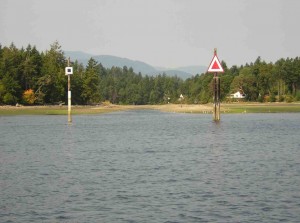
Watching the tide rise
At 10:30 I got impatient and pulled up the anchor. We motored slowly along until we grounded on the mud, then I pulled up the motor. As you know, a short shaft motor only extends exactly as far as a Chebacco’s skeg, but there was a chance we might drift sideways and bend something expensive.
Two views of the cut:

Looking back

Looking ahead
In fact, we had a slight current with us, so as the water level rose, we would unstick and drift forward. We used paddle and boat hook to keep her aligned when we grounded, so we weren’t pushed broadside across the channel, but it was easy work. We eventually made it through at 11:30, the shallowest part being right the western end. We started the motor just long enough to push us into Thetis Island Marina, where we hoped to get showers.
Unfortunately, only those boaters who paid for moorage overnight could have showers, due to a scarcity of water. We were welcome to fill up our five gallon container, though, and we also hit the café for two big pieces of pie and a couple of large mugs of coffee. In less than an hour we cast off again, drifting away under sail.
The wind was disappointing on this side of the island. We managed to sail out of the harbour into Stuart Channel, but made very little progress after that. We wanted to go down the east side of Saltspring Island this time, through Sansum Narrows to Genoa Bay. It eventually became apparent, even to us, that it wasn’t going to happen under sail, not that day anyway, so we fired up Honda and furled the sails.
Honda gave us a pleasant journey, making nothing of the fact that the tide had turned against us at the narrows, and we tied up at Genoa Bay, tucked into larger Cowichan Bay, at 7:15. The office had closed, but the shower building was open, so we were much cleaner and felt a whole lot better when we presented ourselves at the restaurant. This was our treat, the only meal we ate “out” on the trip. However, neither of us were really hungry, so we concentrated on the appetizers and desserts, leaving the entrees for another time. The beer was good, too.
The office was still closed when we left the next morning – unusual for a marina to be keeping banker’s hours at that time of year. (I called a few days later and ‘fessed up, and paid by credit card.) We motored out of Cowichan Bay, hoping to find some wind, but this was to be our big motoring day. We did sail for a while from Cape Keppel to Isabella Island, along the south shore of Saltspring. However, with a strong feeling of déjà vu, we couldn’t overcome the current flowing against us around Isabella – it’s right against the land, more like a point than an island when seen from the sea.
So we called on Honda again, and motored off northeast, towards Prevost Island again. We could have been back at our starting point in Sidney in under an hour, but we weren’t ready to go home just yet. By mid-afternoon we closed our circle around Saltspring Island (and a few others) and were nearing Active Pass, between Galiano and Mayne Islands. When people come to Victoria via BC Ferries, Active Pass is what they remember from the trip. It’s two miles long but only three or four hundred feet wide at times, and it feels like the big ferries are going to graze the sides as they negotiate the two ninety degree turns in the pass.
So naturally, we wanted to sail through this marine freeway.
It’s not as dumb an idea as it sounds as first. The ferries stick to their specified routes, and despite appearances, there’s a lot of water left for the rest of us. As well, they sound their horns before coming around those corners, so there’s lots of notice given. There’s also the schedule, but with the number of vehicles to load in summer, sailing times can be delayed so we didn’t count on that. In any case, we arrived at the pass with a light north wind, which, if it had kept true, would have taken us through on a broad reach. But inside the pass the winds were fluky and unreliable, and the current, which was just barely still with us, swirled around in circles as it moved eastward.
We were about half a mile into the pass when I heard a ship’s siren. I wasn’t sure which end it came from, as it bounced off the islands, but that didn’t matter. We started the motor and moved to the south side, away from the ferry track. A minute later, the Queen of Saanich came into sight from the west, doing about 20 knots. She passed us on the other side of the channel, then before she was out of sight a smaller ferry appeared from the east. We thought this must be the ferry that services Galiano Island, stopping at a dock in Sturdies Bay, just inside the eastern end of Active Pass. As it went by we could see a third ferry approaching, so held our position until the big Spirit of Vancouver Islandhad also passed us, heading west.

The Spirit of Vancouver – don’t mess with this one!
That was it for ferries. It would probably be an hour before the next one came through, but we didn’t try to sail any more because the wind wasn’t reaching us in there. I furled the sails and we completed our transit under power, turning south once we reached Georgia Strait.
We travelled southeast along the “outside” of Mayne Island to Edith Point, where we turned south and negotiated some small channels that eventually led us to Winter Cove, between Saturna and smaller Samuel Island. On the north side of this cove is Boat Passage, a narrow opening to Georgia Strait. The current was flowing into the Cove, so we felt safe in having a look – a strong current in the other direction could have left us stuck in Georgia Strait, and having to go the long way around to get back again – a matter of several miles. As it happened, we had enough power to get out, and of course coming back was no problem.
As we motored over to our chosen anchorage, we altered course slightly to avoid a short pole sticking out of the water. This was nailed to a deadhead, a water soaked, partly sunken log. Next time we’ll give it a wider berth, though, because not far from it was another one, unmarked. We were too late to go wider, we only had time to change course enough to go between the deadheads – not the preferred action, in case of yet another one!
This area has diurnal tides, two highs and two lows each day, and the highs and lows ususally vary in height. The tide table showed a rising tide for most of the afternoon, then a drop of less than a foot, followed by another rise until after midnight. Only then did the level really start to drop, and it wouldn’t be really low until mid-morning the next day. This was important to us because we wanted to anchor off the old log dump, where the park is now. No one else was anchored this close because of the drying rocks and mud shown on the chart. We did the math, and decided that as long as we were out of there by 9:00 in the morning, we’d be all right.

At anchor in Winter Cove, with the boom tent up
After a sound sleep, we were up at 6:00 and glad to see our calculations were sound. We thought we’d better not waste time, but there’s a lot to do each morning to get under way, particularly as we were sleeping in the cockpit. We stowed the air mattresses and rolled up the sleeping bags so we could put the floorboards back where they belonged, took down and folded away the boom tent, cooked breakfast and cleaned up after, then finally deflated the dinghy and stowed that away. So it wasn’t until 8:00 that we were ready to pull up the anchor. By then the bottom was coming up fast, if we’d waited until our 9:00 deadline, we might have been hard aground.
We left Honda alone, raising the sails instead. Dad took the helm and I pulled in the anchor, everything went according to plan and we sailed clear, enjoying a good sneer at another boat that was motoring out. (Yes, I can be a jerk at times.) We were able to clear all the reefs and rocks on a broad reach, then turned towards the wind as our course became clear. We planned to cross Plumper Sound and retrace our path through the channel between North and South Pender. The wind was from the southeast, and at first we thought we’d have to tack our way up to the entrance to Port Browning. However, as we left Saturna, the wind backed around to the south and let us point almost directly at the entrance. We had a fine sail over, only needing one short tack to let us weather the point and run down the harbour.
No sightseeing this time. We went directly to the channel, starting the motor as we neared it. We left the sails up but we were completely sheltered from any breezes. We were through in a minute and had the engine stopped and out of the water again. As we worked our way up Bedwell Harbour, against the wind, we wondered whether to stop for fuel. However, the wind was doing a great job, so we thought we could count on it to take us at least half way home and we’d definitely have enough fuel then. So although our next tack took us within yards of the fuel dock, we turned away again and carried on.
Once out of the harbour, we could easily make our course, passing south of Fairfax Point on Moresby Island, where we spent so much time the first day.

Nearing Moresby Island, going home
Although the wind kept blowing, it wasn’t as strong as it had been, so we thought it best to go as far south as the wind would let us. This way, we hoped to use the tide, which was about to change to flood, to our advantage. This meant we would ideally pass upwind of Forrest Island. Dad held the helm steady as we crept up to the island. He didn’t quite make it without tacking, but only a very short tack was needed. From there we could easily round Sidney Spit and carry on across Sidney Channel to the boat ramp. We passed the spit about noon, docked at 12:45, and had Wayward Lass on the trailer, ready to roll, by 1:30.
Another cruise was over. This one was a huge success, we had expected light and variable winds, and a lot of motoring, but instead we had more sailing than on any other cruise, and good sailing at that. And no rain!
***
Launching Day – Ed Heins
After 6 years 2 states and 4 places of residence, I managed to launch Boudicea, the Chebacco that has doubled as a garage ornament for far too long.
We approached launching day with appropriate plans for celebration including a christening bottle of some not-for-consumption concoction all neatly enclosed in netting, blue blazers, and Deb, my British Lady wife, well rehearsed in her best QE2 accent .
All great ideas, however they didn’t get used today. In fact we launched into probably the most inappropriate venue I’ve ever seen. (Unfortunately, while the Shenandoah Valley in Virginia is resplendant in natural wonders, it exhibits a complete lack of sailing venues) Nevertheless, we dunked the boat and celebrations may follow at a later date and location.
The good news. 1) The trailer rig travelled without a hitch. It’s apparent I need a tongue extension for shallow ramps, but more on that later. 2) we didn’t take on any water we didn’t understand. Yes, the centerboard pivot leaks a bit, but that is a project yet to come. 3) I didn’t fall off the boat, do a bad “Caber Tossing” impression with the main mast, or otherwise. and 4) I arrived at the launch site with everything I needed for a normal set up and launch.
Now the bad news. 1) Lake Shenandoah ( a pond to anyone other than a realtor), is small, narrow, shallow (something the locals are either unaware of, or unwilling to share). Hence we had to push the boat off the trailer, and reloading it was an experience. 2) I’ve got a problem in the gaff rigging that will be resolved before the next attempt at a sail. Please ignore the poor sail set in the attached pics. 3) Probably the worst occurance however was a jammed centerboard in the down position. I placed a block on the board to give better purchase which worked well in dry tests, but apparently after numerous groundings ( refer to item 1, !@###$%^ shallow pond) the block has managed to twist in the trunk. We managed to get the board back up, but damage assessment is on hold till the morrow. Oh well, the great thing about building a boat, is that the repairs are just a continuance of the project.
Next on the agenda is the Atlantic small craft festival in St. Michaels MD. I’m confident that my trailer rig will allow me to get it there. Beyond that it’s anybody’s guess. If anyone should see a statuesque British woman smacking a blue hulled Chebacco with a netted bottle, be advised that things are probably going better the second time around.
“Let the chips fall where they will. I’ve got boats to build.”
Cheers y’all.
Ed Heins
New Market VA



***
Blow-by-blow – Dick Burnham
“Stealing Horses” waits to bolt from her stall, but first…
The construction of the sheet plywood Chebacco, “Stealing Horses,” continues in spurts and stops. I’m learning boatbuilding as I trip merrily along. Last summer we were only able to flip the hull. This summer we’d hoped to wrap up the building and start the sailing, but that didn’t happen. Nevertheless, for what it might be worth, here’s a report.
Since most articles today are on cruising (those lucky ones, huh?), and previous reports were focused on hull construction, I’d like to report a bit on the building of those things above the topsides and inside, just to inspire would-be builders that it is all doable, and pleasurably so. While some have suggested that this work equals, in time, the work of hull building, let me say: Not so! This second phase, what Robb White in MAIB called “furniture building”, is more time consuming. There’s lots more pieces and figuring and head scratching for a novice like me.

Here, from the cockpit looking forward, can be seen the various stringers and carlins for the seats, the deck, and the cuddy roof with mast slot.

The photos show “Stealing Horses” with the cuddy, deck, and cockpit seats about ready for covering. The cuddy walls are solid ½” thick rosewood, saved from previous travels. The cuddy roof carlins are the same wood, but the deck and other framing members are spruce which is encapsulated in epoxy. Building the cuddy walls was a matter of repeated fittings so that the bottom hit right and there was extra height on top. As others have suggested, I cut the elliptical windows while the trunk was flat on sawhorses. With the trunks in place, the bottom carlins were then added, with ring nails and epoxy. Then the top carlins of the walls were added after using bendy battens to get it right. Next, the other roof-framing members were sized and put in, with recessed silicon bronze screws that were bunged. Epoxy is always used to butter the joints.
The rounded nosepiece of the cuddy was made up of several 1” thick wood pieces, fitted through trial and error, and put in with epoxy. It was shaped in place with a handsaw, a rasp, and sandpaper on a board. (I’ve since bored a hole in its prow and inserted a coin from the South Pacific, setting it in epoxy that will be UV filtered with varnish.)
The tops of the carlins and the cuddy wall were shaped to final form with a handheld power planer and a belt sander (36 and 50 grit!). I did this portion “wrong” as, according to Phil Bolger, he’d premised his detailing based on a sequence that had the the deck down before the cuddy trunks. Nevermind! I had it done before I wrote to him!

The cuddy roof went down easily with two layers of ¼” plywood. The curve was fun to do and was easily accomplished with ring nails and epoxy. I prepainted the cuddy ceiling but it was accidentally smeared with thickened epoxy and now I think that prepainting was a waste of time. The sliding hatch runners went on as did the framing for the mast slot hatch—screws and epoxy. The hatch was a head-scratcher, but I’ve worked it out, adding extra hand-holds and/or places for lines to be tied.

Xynole fabric in epoxy covered the deck and cuddy roof. The process I’m using, taken from Reuel Parker’s book, “The New Cold-Molded Boatbuilding”, is this: roll regular epoxy on the plywood (it is, by the way, Meranti marine grade – I think grade BS6566 – from Noahsmarine in Toronto). Then, the next day, tape the xynole down and squeegee into it one coat of epoxy (my epoxy guy, Larry at Raka Epoxy, suggested adding some fumed silica to this and the next step for some thickening—I did this). The day after, roll on one more coat of epoxy. The cloth is now hard and “rough” and was then sanded down just a bit for a finished ‘roughened’ surface good for footing but not too rough for those who will slip! This will now receive 2 coats of semi-gloss paint (I use Kirby’s and have selected a color that won’t have too much glare).
The curved returns of the coaming were built up and installed, and I’ve added a veneer of about 3/16” thick wood to the forward bulkhead of the cockpit as well as to the outside of the coaming. A continuous band of natural wood runs from the cuddy prow all the way aft along the coaming to the transom. This will be varnished and hopefully look nice against the white topsides.
The rubrails have been put together from pieces, shaped, epoxied on the backs and I plan to paint them with repeated applications of Kirby’s “Salty Dog Deck Oil” – a pine tar based mixture for these pieces of wood that will be subjected to abrasion.
That’s where I am in September. Before frost and winter arrive, the hopes are to paint the deck and roof, install the rubrails and the trim at the cuddy roof edge, varnish the wood, and start mast building. Working up steam to have a go at the masts and gaff, I’ve built a sample section using the hollow ‘birdsmouth’ design idea that was featured in WoodBoat magazine (July/August 1999). At the same time, however, I’ve put the sicklebar onto the tractor and am belatedly out in the field mowing, so who knows what will get done!

***
Kitty Hawk in the Po Delta – Vincenzo Ciminale
Dear Richard,
Attached is a photo of Kitty Hawk with all of her sails up, gliding along in the Po Delta with barely any wind. In August 2001, Kitty was launched with standard Chebacco main and mizzen sails. From the start it was clear that she would need additional sail area for the very light winds that prevail in the Venice lagoon during the summer months. We first rigged up a jib on a retractable bowsprit, with a jib roller. The jib, which is about 5.5 square meters (about 60 sq ft), adds at least one knot of speed and corrects Kitty’s weather helm. When the situation really gets desperate, we rig up the mizzen staysail. This sail is about 4 square meters and is a recycled jib from a traditional lugsailer. The mizzen staysail works well on long tacks, from close-hauled to broad reach. To tack, we have to detach the tack of sail sail and walk it around the boom and reattach it.
We would like to launch an idea – a Chebacco foreign exchange program. For example, we would welcome other Chebacco sailers to visit and use our boat for a weekend in the Venice lagoon, and would appreciate the possibility of sailing other boats and meeting other Chebacco sailers.
Buon Vento
Donna D’Agostino
Vincenzo Ciminale
